No Effort Longtail SEO Revenues, from FindTheBest
In our infographic about the sausage factory that is online journalism, we had a throw away line about how companies were partnering with FindTheBest to auto-generate subdomains full of recycled content. Apparently, a person named Brandon who claims to work for FindTheBest didn’t think our information was accurate:
Hi Aaron,
My name is Brandon. I have been with FindTheBest since 2010 (right after our launch), and I am really bummed you posted this Infographic without reaching out to our team. We don’t scrape data. We have a 40 person+ product team that works very closely with manufacturers, companies, and professionals to create useful information in a free and fair playing field. We some times use whole government databases, but it takes hundreds-of-thousands of hours to produce this content. We have a product manager that owns up to all the content in their vertical and takes the creation and maintenance very seriously. If you have any questions for them about how a piece of content was created, you should go to our team page and shoot them a email. Users can edit almost any listing, and we spend a ton of time approving or rejecting those edits. We do work with large publishers (something I am really proud of), but we certainly do not publish the same exact content. We allow the publishers to customize and edit the data presentation (look, style, feel) but since the majority of the content we produce is the factual data, it probably does look a little similar. Should we change the data? Should we not share our awesome content with as many users as possible? Not sure I can trust the rest of your “facts”, but great graphics!
I thought it was only fair that we aired his view on the main blog.
…but then that got me into doing a bit of research about FindTheBest…
In the past when searching for an issue related to our TV I saw a SERP that looked like this

Those mashed sites were subdomains on trusted sites like VentureBeat & TechCrunch.
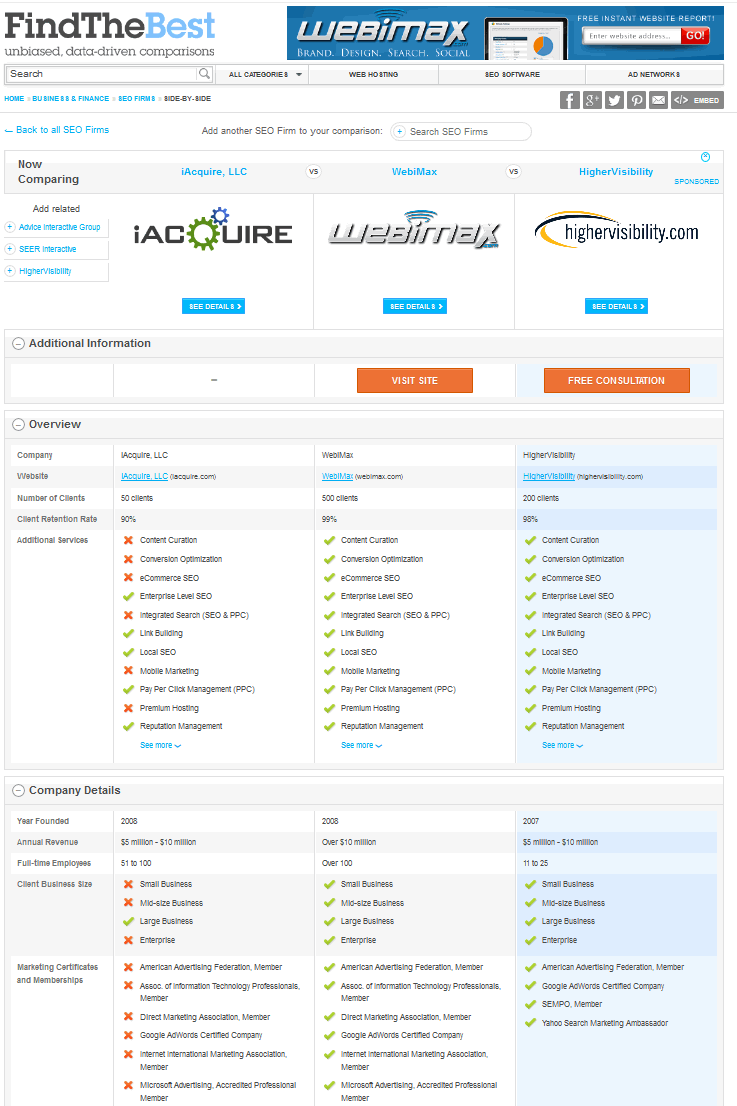
Graphically the comparison pages appear appealing, but how strong is the editorial?
How does Find The Best describe their offering?
In a VentureBeat post (a FindTheBest content syndication partner) FTB’s CEO Kevin O’Connor was quoted as saying: “‘Human’ is dirty — it’s not scalable.”
Hmm. Is that a counter view to the above claimed 40 person editorial research team? Let’s dig in.
Looking at the top listed categories on the homepage of Find The best I counted 497 different verticals. So at 40 people on the editorial team that would mean that each person managed a dozen different verticals (if one doesn’t count all the outreach and partnership buildings as part of editorial & one ignores the parallel sites for death records, grave locations, find the coupons, find the company & find the listing).

Google shows that they have indexed 35,000,000 pages from FindTheBest.com, so this would mean each employee has “curated” about 800,000 pages (which is at least 200,000 pages a year over the past 4 years). Assuming they work 200 days a year that means they ensure curation of at least 1,000 “high quality” pages per day (and this is just the stuff in Google’s index on the main site…not including the stuff that is yet to be indexed, stuff indexed on 3rd party websites, or stuff indexed on FindTheCompanies.com, FindTheCoupons.com, FindTheListing, FindTheBest.es, FindTheBest.or.kr, or the death records or grave location sites).








Maybe I am still wrong to consider it a bulk scrape job. After all, it is not unreasonable to expect that a single person can edit 5,000 pages of high quality content daily.
Errr….then again…how many pages can you edit in a day?
Where they lost me though was with the “facts” angle. Speaking of not trusting the rest of “facts” … how crappy is the business information for SEO Book on FindTheBest that mentions that our site launched in 2011, we have $58,000 in sales, and we are a book wholesaler.
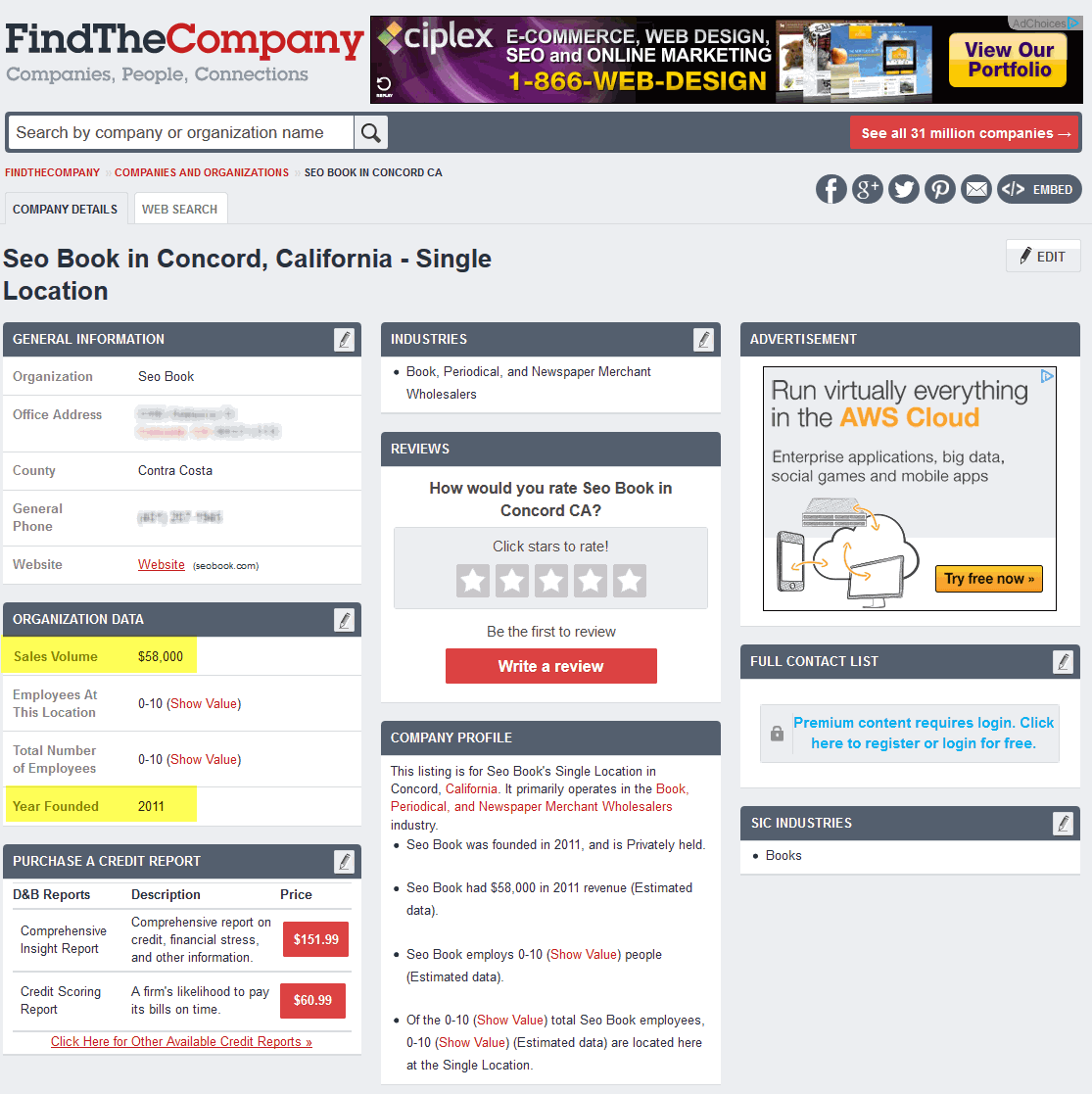
I realize I am afforded the opportunity to work for free to fix the errors of the scrape job, but if a page is full of automated incorrect trash then maybe it shouldn’t exist in the first place.
I am not saying that all pages on these sites are trash (some may be genuinely helpful), but I know if I automated content to the extent FTB does & then mass email other sites for syndication partnerships on the duplicate content (often full of incorrect information) that Google would have burned it to the ground already. They likely benefit from their CEO having sold DoubleClick to Google in the past & are exempt from the guidelines & editorial discrimination that the independent webmaster must deal with.
One of the ways you can tell if a company really cares about their product is by seeing if they dogfood it themselves.
Out of curiousity, I looked up FindTheBest on their FindTheCompany site.

They double-list themselves and neither profile is filled out.
That is like having 2 sentence of text on your “about us” page surrounded by 3 AdSense blocks. :D
I think they should worry about fixing the grotesque errors before worrying about “sharing with as many people as possible” but maybe I am just old fashioned.
Certainly they took a different approach … one that I am sure that would get me burned if I tried it. An example sampling of some partner sites…
- accountants.entrepreneur.com
- acronyms.sciencedaily.com
- alternative-fuel.cleantechnica.com
- analytics-software.businessknowhow.com
- antivirus.betanews.com
- apps.edudemic.com
- atvs.agriculture.com
- autopedia.com/TireSchool/
- autos.nydailynews.com
- backup-software.venturebeat.com
- bags.golfdigest.com
- beer.womenshealthmag.com
- best-run-states.247wallst.com
- bestcolleges.collegenews.com
- bikes.cxmagazine.com
- bikes.triathlete.com
- birds.findthelisting.com
- birth-control.shape.com
- brands.goodguide.com
- breast-pumps.parenting.com
- broker-dealers.minyanville.com
- businessschools.college-scholarships.com
- camcorders.techcrunch.com
- cars.pricequotes.com
- cats.petharbor.com
- catskiing.tetongravity.com
- chemical-elements.sciencedaily.com
- comets-astroids.sciencedaily.com
- companies.findthecompany.com
- companies.goodguide.com
- compare-video-editing-software.burnworld.com
- compare.consumerbell.com
- compare.guns.com
- compare.roadcyclinguk.com
- comparemotorbikes.motorbike-search-engine.co.uk
- congressional-lookup.nationaljournal.com
- courses.golfdigest.com
- crm.venturebeat.com
- cyclocross-bikes.cyclingdirt.org
- dealers.gundigest.com
- death-record.com
- debt.humanevents.com
- design-software.underworldmagazines.com
- destination-finder.fishtrack.com
- diet-programs.shape.com
- digital-cameras.techcrunch.com
- dinosaurs.sciencedaily.com
- dirt-bikes.cycleworld.com
- dogbreeds.petmd.com
- dogs.petharbor.com
- donors.csmonitor.com
- e-readers.techcrunch.com
- earmarks.humanevents.com
- earthquakes.sciencedaily.com
- ehr-software.technewsworld.com
- fallacies.sciencedaily.com
- fec-candidates.theblaze.com
- fec-committees.theblaze.com
- federal-debt.nationaljournal.com
- fha-condos.realtor.org
- fha.nuwireinvestor.com
- financial-advisors.minyanville.com
- findthebest.com
- findthebest.motorcycleshows.com
- findthecoupons.com
- findthedata.com
- firms.privateequity.com
- franchises.fastfood.com
- ftb.cebotics.com
- game-consoles.tecca.com
- game-consoles.venturebeat.com
- gin.drinkhacker.com
- golf-courses.bunkershot.com
- gps-navigation.techcrunch.com
- gps-navigation.venturebeat.com
- green-cars.cleantechnica.com
- guns.dailycaller.com
- ham-radio.radiotower.com
- hdtv.techcrunch.com
- hdtv.venturebeat.com
- headphones.techcrunch.com
- headphones.venturebeat.com
- high-chairs.parenting.com
- highest-mountains.sciencedaily.com
- hiv-stats.realclearworld.com
- horsebreeds.petmd.com
- hospital-ratings.lifescript.com
- hr-jobs.findthelistings.com
- inventors.sciencedaily.com
- investment-advisors.minyanville.com
- investment-banks.minyanville.com
- iv-housing.dailynexus.com
- laptops.mobiletechreview.com
- laptops.techcrunch.com
- laptops.venturebeat.com
- lawschool.lawschoolexpert.com
- locategrave.org
- mammography-screening-centers.lifescript.com
- mba-programs.dealbreaker.com
- medigap-policies.findthedata.org
- military-branches.nationaljournal.com
- motorcycles.cycleworld.com
- mountain-bikes.outsideonline.com
- nannies.com
- nobel-prize-winners.sciencedaily.com
- nursing-homes.caregiverlist.com
- nursing-homes.silvercensus.com
- onlinecolleges.collegenews.com
- phones.androidauthority.com
- pickups.agriculture.com
- planets.realclearscience.com
- planets.sciencedaily.com
- plants.backyardgardener.com
- presidential-candidates.theblaze.com
- presidents.nationaljournal.com
- privateschools.parentinginformed.com
- processors.betanews.com
- project-management-software.venturebeat.com
- projectors.techcrunch.com
- pushcarts.golfdigest.com
- recovery-and-reinvestment-act.theblaze.com
- religions.theblaze.com
- reviews.creditcardadvice.com
- saving-accounts.bankingadvice.com
- sb-marinas.noozhawk.com
- sb-nonprofits.noozhawk.com
- scheduling-software.venturebeat.com
- scholarships.savingforcollege.com
- schools.nycprivateschoolsblog.com
- scooters.cycleworld.com
- smartphones.techcrunch.com
- smartphones.venturebeat.com
- solarpanels.motherearthnews.com
- sports-drinks.flotrack.org
- stables.thehorse.com
- state-economic-facts.nationaljournal.com
- steppers.shape.com
- strollers.parenting.com
- supplements.womenshealthmag.com
- tablets.androidauthority.com
- tablets.techcrunch.com
- tablets.venturebeat.com
- tabletsandstuff.com/tablet-comparison-chart
- tallest-buildings.sciencedaily.com
- technology.searchenginewatch.com
- telescopes.universetoday.com
- tequila.proof66.com
- texas-golf-courses.texasoutside.com
- tires.agriculture.com
- tractors.agriculture.com
- tsunamies.sciencedaily.com
- us-hurricanes.sciencedaily.com
- video-cameras.venturebeat.com
- volcanic-eruptions.com
- waterheaters.motherearthnews.com
- wetsuits.swellinfo.com
- whiskey.cocktailenthusiast.com
- whiskey.drinkoftheweek.com
- white-house-visitors.theblaze.com
- wineries.womenshealthmag.com
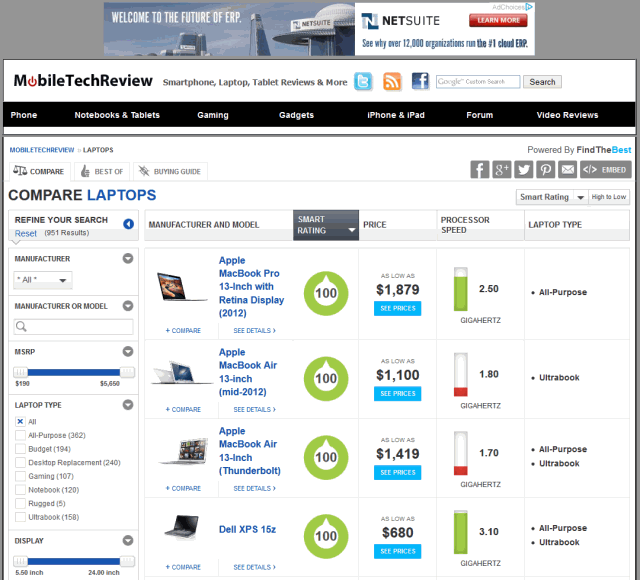


we have seen search results where a search engine didn’t robots.txt something out, or somebody takes a cookie cutter affiliate feed, they just warm it up and slap it out, there is no value add, there is no original content there and they say search results or some comparison shopping sites don’t put a lot of work into making it a useful site. They don’t add value. – Matt Cutts
That syndication partnership network also explains part of how FTB is able to get so many pages indexed by Google, as each of those syndication sources is linking back at FTB on (what I believe to be) every single page of the subdomains, and many of these subdomains are linked to from sitewide sidebar or footer links on the PR7 & PR8 tech blogs.

And so the PageRank shall flow ;)
Hundreds of thousands of hours (eg 200,000+) for 40 people is 5,000 hours per person. Considering that there are an average of 2,000 hours per work year, this would imply each employee spent 2.5 full years of work on this single aspect of the job. And that is if one ignores the (hundreds of?) millions of content pages on other sites.
How does TechCrunch describe the FTB partnership?
Here’s one reason to be excited: In its own small way, it combats the recent flood of crappy infographics. Most TechCrunch writers hate the infographics that show up in our inboxes— not because infographics have to be terrible, but because they’re often created by firms that are biased, have little expertise in the subject of the infographic, or both, so they pull random data from random sources to make their point.
Get that folks? TechCrunch hosting automated subdomains of syndicated content means less bad infographics. And more cat lives saved. Or something like that.
How does FTB describe this opportunity for publishers?
The gadget comparisons we built for TechCrunch are sticky and interactive resources comprised of thousands of SEO optimized pages. They help over 1 million visitors per month make informed decisions by providing accurate, clear and useful data.
SEO optimized pages? Hmm.
Your comparisons will include thousands of long-tail keywords and question/answer pages to ensure traffic is driven by a number of different search queries. Our proprietary Data Content Platform uses a mesh linking structure that maximizes the amount of pages indexed by search engines. Each month—mainly through organic search—our comparisons add millions of unique visitors to our partner’s websites.
Thousands of long-tail keyord & QnA pages? Mesh linking structure? Hmm.
If we expand the “view more” section at the footer of the page, what do we find?

Holy Batman.
Sorry that font is so small, the text needed reduced multiple sizes in order to fit on my extra large monitor, and then reduced again to fit the width of our blog.
Each listing in a comparison has a number of associated questions created around the data we collect.
For example, we collect data on the battery life of the Apple iPad.
An algorithm creates the question “How long does the Apple iPad tablet battery last?” and answers it
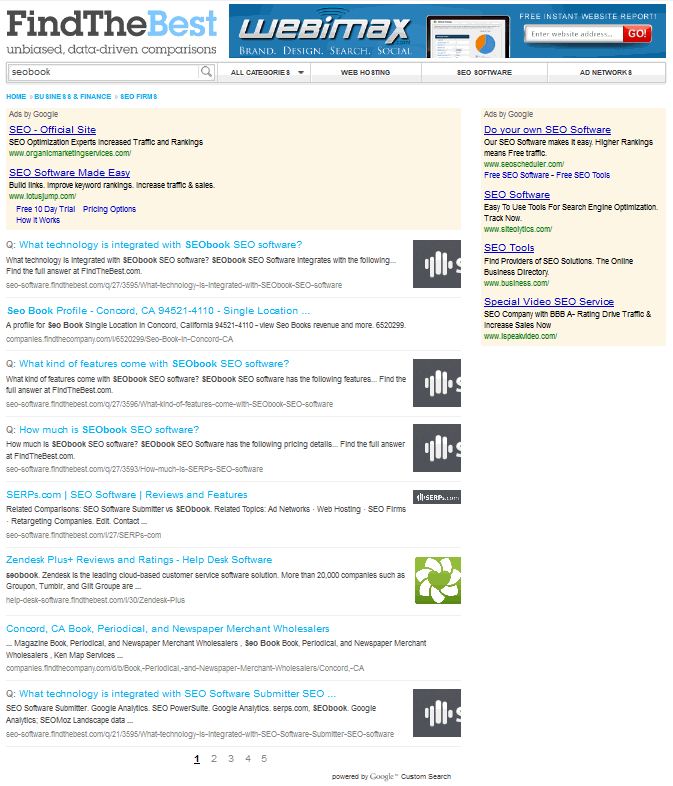
So now we have bots asking themselves questions that they answer themselves & then stuffing that in the index as content?
Yeah, sounds like human-driven editorial.
After all, it’s not like there are placeholder tokens on the auto-generated stuff

{parent_field}
Ooops.
Looks like I was wrong on that.
And automated “popular searches” pages? Nice!
As outrageous as the above is, they include undisclosed affiliate links in the content, and provided badge-based “awards” for things like the best casual dating sites, to help build links into their site.

That in turn led to them getting a bunch of porn backlinks.

If you submit an article to an article directory and someone else picks it up & posts it to a sketchy site you are a link spammer responsible for the actions of a third party.
But if you rate the best casual dating sites and get spammy porn links you are wonderful.
Content farming never really goes away. It only becomes more corporate.

How To Write A Marketing Plan

A marketing plan is a document that outlines a set of actions necessary in order to meet specific objectives.
It’s one of those things many of us, especially those who have been doing search marketing for a while, probably keep largely in our heads. We know roughly where we’re going, the strategies needed to get there, and the objective is to get great rankings and increased traffic. So who needs to write it down?
Here’s a couple of good reasons.
Writing forces an analytic approach. The act of writing something down often brings about new ideas because it gets us out of the routine of “just doing”. Secondly, writing plans helps us write better proposals. A marketing plan is about both an analysis and a form of communication. It’s a means to get across your ideas to clients and other partners and convince them of the merits of what we’re doing.
If your clients are anything above small business level, then they likely already have formal marketing plans, of which search marketing is a part, so doing this sort of planning makes us better able to talk their language.
This post looks at the steps involved in writing a marketing plan, and how to optimize it so it will be most effective.
What Is A Marketing Plan?
A marketing plan:
- provides an analysis of the current situation
- lists goals
- outlines strategies, tactics and recommendations to achieve those goals
Above all, a marketing plan is a recommendation for a course of action.
How To Write A Marketing Plan
A marketing plan should cover the following topics:
- Summary & Recommendations
- Situation analysis
- Objectives
- Budget
- Strategy
- Execution
- Evaluation
The summary and recommendations outline the state of the market and your recommendations for achieving goals. The rest of your document supports these recommendations.
A situation analysis covers what is happening both inside and outside the company – the internal and external conditions. There are various methods of defining these conditions including SWOT analysis, Five Forces, and 5Cs. Whatever method you choose, they will include these three areas:
- The Customer
- The Competitors
- The Company
Customer: A company must serve the interests of the customer. What does the customer need?
Competitor: What do competitors offer? What are the points of difference between their company and yours? Do they serve the needs to the customer well? In what areas don’t they serve the needs of customers?
The Company – what makes sense in terms of existing resources? Could the company restructure to meet marketing goals? Could some product and service lines be switched?
A situation analysis is typically detailed and draws a picture of the state of play right now. It’s a list of known facts about internal and external forces.
The situation analysis is where you are now, the objectives are where you want to be and when. Objectives, as far as a business is concerned, are typically about the bottom line and increasing profitability.
Search marketers often think of micro-objectives in terms of rankings and positioning, but a question a client is much more interested in is how this ranking or positioning effort supports the macro-objective: greater profitability?
A high ranking might lead to more inquiries, and inquiries convert at X%, which are worth, on average, $X to the business. Once you link search marketing objectives to business objectives it’s a lot easier to sell search marketing and convince people of your strategies, particularly to decision makers.
Objectives such as convert x % more customers, get x more customers to landing page y, get x% more signups are all valid marketing goals as they are quantitative and therefore concrete. “Getting higher rankings” may be measurable, but it doesn’t, in itself, align with a business goal. If we can marry those two things together – rankings and higher profits – then search becomes an easy sell.
Traffic is another measurement we could use, or break it down further into types of traffic i.e. tightly targeted vs loosely targeted traffic. Whilst these facts may be difficult to pin down, this type of analysis helps people think about exactly how much each visitor is worth to them, and why. If each visitor has measurable value, then the value of search marketing plans are easy to prove, so long as the total search marketing spend is lower than the added value the visitors represent. One way to illustrate this potential is by using Google Adwords search volume data, or for a more accurate barometer – a trial PPC campaign run against desired keywords.
Budget: How much will the plan cost to execute? Once you can demonstrate the value of search traffic, then it becomes easier for a company to allocate budget.
Strategy: the nuts and bolts of how you will achieve your goals. In search marketing, this is typically split into two areas, PPC and SEO. A marketing plan typically doesn’t go into exact detail in terms of ranking and positioning technique. Keep it high level, else it’s likely to confuse, or people are likely to get bogged down in unnecessary detail.
Execution: Define who is responsible for what and when. Include milestones.
Evaluation: Evaluation is critical in that you need to establish if the plan is on target to meet goals, or has met goals. If not, then you may need to revise goals and strategy in order to get the plan back on track.
Planning often seems dry, but the very act of putting together a marketing plan will help give you fresh ideas, help clarify your approach, and makes it all easier to communicate with stakeholders.
One problem at this stage is that the marketing plan is likely to be a dull read. I’ve seen chunky marketing plans that never get read – a lot of managers appear to just read the summary on such documents – because they are too dense. In the next section, we’ll look at ways to optimize marketing plans so that people will read them, remember them, and get enthusiastic about them.
It’s useful to split out the phases and a different type of thinking is required for each. Phase one is an analysis – a list of what is happening now. Phase two is all about strategy and tactics. It’s all about “how”. Phase three is about communication and getting people on side. It’s about making specific recommendations backed by analysis and strategy.
Optimizing Your Marketing Plan
Think of your audience. What would you want to see if you were reading a marketing plan?
You’d want to know what needs to be done, and even more importantly, why this is the best course of action. Recommendations need to be anchored by solid analysis and presentation of facts. If you assert something as a recommendation, ask yourself what questions such a recommendation invites, then have the facts to back them up. Always answer the “why are we doing this?” question.
A good way of engaging people is to use a story format. Stories pull people in as they have internal consistency whereby one sentence logically leads to another. A story is simply this: something that moves from status quo (your analysis), to a problem that must be resolved (the customers needs), to a new status quo. Show how you resolve that problem (target the customer and deliver what they need).
Example Marketing Plan
Some marketing plans are long and detailed, but that doesn’t need to be the case, especially on small, contained projects. Here’s an example of a brief marketing plan incorporating each of the steps outlined above.
Example:
Many people want to travel by private plane, but can’t afford it.
Many private planes sit idle, or make return journeys with no one on them. PrivateJet Inc has adapted their existing booking system to provide a service whereby people can book a seat on a private plane just like they can on a regular airline. When carriers have spare capacity, they post it to the system, and pre-approved customers who want to book a seat can easily do so.
Currently, private plane operators don’t have an easy way of making their spare capacity available, except as charters. There are no direct competitors in the private “book a seat” market. People who wish to travel on private aircraft don’t have an easy way of accessing this type of travel. There is space in the market for a nationwide booking system that pre-screens appropriate passengers and matches them up with available planes, much like a conventional aircraft booking system. PrivateJet Inc has this system, and this plan outlines a plan to reach our identified market segment of prospective cash-rich but time poor business customers who can’t afford to own or charter a private plane but would benefit from the convenience of being able to book a seat on one. Private Jet Inc already have a number of private aircraft operators lined up to provide the service.
The goal is to sign-up 2,000 interested members of the public to the prospects database by July 20th. We plan to achieve this goal by using pay per click advertising on Google. The budget for this activity is is $15,000. We’ve noted that there is significant search volume for “private plane charter” and various related keywords, so feel confident on achieving this goal given we an estimated conversion rate of 5%. We intend to set-up specific landing pages for each group of related keyword terms explaining the offer and requesting interested users sign up to our mailing list.
Search Inc will implement the plan immediately and report progress to PrivateJet Inc on a weekly basis. By July, PrivateJet will have 2,000 interested members signed up to their prospect database.
That’s a very simple plan for the purposes of illustration. Marketing plans are typically significantly longer and more detailed, but they will follow that same basic structure. It’s clear what the problem is, how it will be addressed, by whom, and when things will happen.
Further Reading:
How To Analyze An Industry

Are you planning on starting a new website but want to gauge how profitable the industry sector is before you do? Are you optimizing a site for a client but want to gain a better understanding of the industry in which they operate? Conducting an industry analysis will help identify advantages and any weaknesses a business may have in that industry, and clarify the forces that shape that industry. The better we understand the industry, the more likely we are to grasp the opportunities others may miss.
If a business has a weak position relative to their competitors then optimization efforts might be ineffective as customers will simply click a few different search results and compare offerings.
Then again, a business may enjoy advantages in areas that aren’t currently being exploited. Focusing your optimization and positioning efforts in these areas will likely pay higher dividends than optimizing in areas where competitors are strongest. Understanding the forces at work in the industry will help reveal these areas.
I like to analyze industries prior to the optimization process as I find I get a lot of ideas just by breaking the industry down into component parts. Where is the profit in this industry? Is this industry growing quickly? If so, should the emphasis be on acquiring new customers? Or is it stagnant, in which case should the emphasis be on taking market share from competitors? What areas do competitors focus on? What areas do they miss? Where are competitors most vulnerable?
There are various frameworks for conducting an industry analysis. You may have heard of a SWOT analysis, but today we’ll take a look at Porter’s Five Forces analysis.
Why Industry Analysis Is Useful
If you were examining the web design industry, you’d soon come across crowdsourcing sites, such as 99designs.
The existence of these types of sites signal a power imbalance in the design industry. The customer has significant power in that they can request that professional designers submit near-finished work in order to compete for their business.
Some may argue that this is a marketing cost for designers – a way to advertise and get in front of people, but however we look at it, it soon becomes clear the profitability of the web design industry is constrained by two forces: the power of buyers and the low barrier to entry to new competitors. Just about anyone can set-up shop as a web designer. Since suppliers are plentiful, the buyers can easily play the suppliers off against one another – quite literally, in the case of 99designs!
Once we understand these industry forces, we could alter our plan of attack if we were marketing a web design agency. One possible approach would be to focus on geographical advantages. If you’re a web designer based in New York, you’re probably going to get more work out of New York based firms than if you lived in Oklahoma. A marketing campaign that emphasizes the unique selling point of physical location might work well in that it mitigates a force that is strong and operates against them i.e. the number of competitors. If they focus on local, they’ll be competing with local designers, not designers from all over the country, or around the world. Such a business might make a big deal of the fact they’ll come and see their clients face-to-face, their centrally located offices, their geographic location, and the fact they have local knowledge and contacts.
That unique selling point is determined once we’ve made an effort to understand the forces at work in the industry.
The Five Forces
The five forces are:
- The Power Of Suppliers
- The Power Of Buyers
- Barriers To Entry
- Competitive Rivalry
- The Availability Of Substitutes
If there are unfavourable power imbalances in a few of those forces, then the industry as a whole is likely to have profitability problems that need to be countered. Here is a further breakdown of these areas, as well as a five forces worksheet.
Let’s compare our web design agency against those five forces.
Power Of Suppliers? Suppliers being people who supply the web businesses with anything they need to produce their output. Suppliers, such as graphics software vendors, have virtually no power in the web design industry. A web designer needs a computer, office space and software, all of which are commodity items. Supply risk is therefore not a significant threat to the profitability of web designer businesses.
The Power Of Buyers? High. Buyers have a lot of choice as the industry is saturated with suppliers.
Barriers To Entry? Low. Anyone with a computer, design skills, and an internet connection can compete.
Competitive Rivalry? Medium/High. There are a lot of agencies chasing prestige work and may take a loss to land work from name companies. This gives them bragging rights and the association may help future marketing efforts.
The Availability Of Substitutes? Medium. A website is a marketing channel. A company could decide to spend money on other channels. They could substitute web design spend for some other marketing spend.
This industry clearly has profitability challenges. By emphasizing local, and a high touch service, a design firm could counter the competitive rivalry force and the barrier to entry force to some degree, and thus limit the power of buyers by focusing on buyers who place high value on face-to-face meetings. That’s just one idea, I’m sure you can think of a few more, but notice how easily these ideas spring to mind once you have a good idea of the forces at work in the industry.
How To Make A Five Forces Analysis
Define The Industry:
- What are the geographic boundaries of this industry?
- What products and/or services are in this industry?
Define The Players:
- Who are the buyers?
- Who are the suppliers?
- Who are the competitors?
- What are the substitutes?
- Who are the potential entrants?
What are the drivers of each competitive force? Grade them on relative weakness vs strength. Make a note of why they are either weak or strong.
Determine Industry Structure
- Why is this industry profitable?
- What forces make it profitable?
- Are some competitors better positioned in terms of the five forces than others?
Analyze Changes
- Which forces are changing now, or likely to change in future? Can your business bring about any of these changes? Can your competitors?
Digging Deeper
A common mistake when undertaking this analysis is to define competition too narrowly. Competition is often deemed to be “the other guy who offers the same service”, and that’s the end of it.
By examining each force, we gain a more thorough understanding of how competition works in the industry. This can be useful when constructing an seo/sem campaign, as you may be able to find weak forces in one or more areas that you can exploit. For example, one opportunity might be substitute products. What is your clients product or service a substitute for? You could then target the existing customers of another substitute product or service and encourage them to switch.
Why Five?
The five forces help determine the potential of an industry as they keep us from focusing on any one element. We need to consider all elements in order to get a better idea of industry profitability.
For example, we may note that an industry is growing quickly, but if we disregard the fact there is no barrier to entry, we might overestimate the profit potential. The search marketing industry has been growing quickly, but there are no barriers to entry, so this shifts a lot of power to the buyer and away from suppliers. It’s also an industry where numerous substitution options exist i.e. there are numerous internet marketing channels, and it’s possible some customers will get more bang for their buck using other channels.
The five factors strategy helps us see how much profit is bargained away to customers and suppliers. We focus on structural considerations as a whole, as opposed to isolated factors.
Defining The Industry
It can often be difficult to determine the industry boundaries.
An industry can be defined too broadly or too narrowly. For example, an analysis of the web marketing industry may determine it is global, however marketing is often highly dependent on cultural aspects. A more narrow industry definition, including regionality and geographical factors, might be more applicable when it comes to quantifying the level of competition. The marketing industry in the USA is a different “industry” from the marketing industry in France as most marketing activity undertaken in the US is conducted by US based marketing companies, and very little by suppliers from France. Therefore, the supplier in France and the supplier in the US are in “different” industries from a competitive standpoint. One does not compete directly with the other as their focus is likely to be on their own geographic markets.
There are two main factors in deciding industry boundaries:
- Scope of the products or services
- Geographical boundaries. Does competition take place globally, or is it regional?
You can use the five forces to help determine the industry boundaries. If the industry structure is the same i.e. same buyers, same suppliers, barriers to entry, and so on, then treat it as the same industry. If the industry forces are different, then treat it as a separate industry for the purposes of this analysis.
Are soft drinks for the home and soft drinks for corporate buyers – such as McDonalds – the same industry for the purposes of analysis? Possibly not. Soft drinks to consumers are heavily marketed on b2c channels and packaged in small, individual containers. Distribution needs to be very wide to get each of these small containers physically close to the consumers. Into vending machines, for example. Sales of soft drinks to corporate buyers, however, are likely to occur via b2b channels, where purchasing is done strategically and delivery is in the form of bulk syrup. The forces are quite different, even though product is exactly the same.
Barrier To Entry
When the barrier to entry is low, incumbents must hold down their prices or boost investment to deter new entrants. The way to counter a low barrier to entry force is attempt to raise it.
Anyone can make a burger, and anyone can get into the burger making business, but few could compete with McDonalds. McDonalds counter the low barrier to entry force by buying up well-positioned locations, operating at significant scale to keep prices low, and investing heavily in brand awareness. This raises the barrier to entry for anyone trying to offer something similar to McDonalds.
Many SEO companies spend a lot of time at conferences and keeping their names “out there”, which goes some way to counter the low barrier to entry in a business where just about anyone can call themselves an SEO. Software companies will likely invest heavily in features, R&D or service levels to ensure new entrants have a steep hill to climb in order to compete.
If the barriers to entry are low, then the threat of entry is high, which in turn limits profitability unless demand in the industry is growing faster than supply. Some businesses, like McDonalds, will counter this force with sheer scale, driving down the cost per unit. You can only compete with McDonalds pricing and convenience advantages if you do so at scale, and that scale is expensive. New entrant competitors in the burger business often position in areas where McDonalds are weakest i.e. offering gourmet burgers that that might cost more, but aren’t generic. Competitors could make a big deal about being small.
The advantages of economies of scale can be found throughout the value chain and the reason why companies tend to get bigger – they have to – else they put themselves at ongoing risk from new entrants.
The downside risk for these companies is that they can’t change and adapt quickly. It’s like trying to maneuver a container ship, whilst the small business can change direction on a whim. The small business is like the speedboat, the big business is like a container ship. This is the reason small companies tend to focus on new, innovative areas of the market. The big companies may not be able to make money out of these areas (yet) due to company cost structures and/or they can’t adapt quickly enough to seize these opportunities.
Another benefit of scale that we see often on the web is demand-side economies of scale, otherwise known as network effects. Anyone can start a social network, but few can compete with Facebook. Their competitive advantage is largely due to network effects – the more people on a social network, the more value it has, and the more people will be willing to join. These demand side economies of scale erect a barrier to entry, thus retaining and increasing profitability, because customers are unwilling to sign up to smaller networks. This demand side barrier has been so effective for Facebook that even the likes of Google have trouble countering it.
We could even apply this type of analysis to the search results. If some serps are “easy” to get, then you may experience profitability issues. If they are easy for you to get, they are easy for some new entrant to get, too. As Google raises the bar, and makes it more expensive to compete, the threat from new entrants and/or those with less funding diminishes. Those who have more to spend, and/or are bigger businesses will likely find the serps more profitable than in the past as they no longer suffer the structural problem of a low barrier to entry. If you have the funds, then Google making it harder to optimize actually works in your favour.
Switching Costs
Almost everything has a switching cost whereby it costs a customer to change services. The more entrenched a product or service, the higher the switching cost, and therefore the higher the barrier to competitors. Microsoft Office has hung around in the enterprise, despite being less than ideal, because the switching cost – involving staff training and industry document standards – is high.
Capital Requirements
If you want to run a search engine to rival Google, then the capital requirements are significant.
However, if the return is there, capital is typically available, especially if the capital can be turned back into cash if the business doesn’t work out.
For example, the bank might be happy to lend on a hotel as they can still convert their capital back into cash by selling the asset. If a business relies on a large advertising spend, however, then capital may be more difficult to come by as it can’t be converted back into cash if things go badly. Capital alone is not a significant barrier to entry.
Incumbency
Incumbency can counter low barriers to entry. It’s easy to start a search blog, but difficult to draw attention away from the incumbents in this space. The established sites have built up loyal audiences over time. To beat incumbents, you’ve usually got to do something remarkably superior, complementary, or be prepared for a long battle.
Application Of Five Forces Theory
Start by evaluating your position against the five main criteria and identify where forces are strong and where they are weak.
If the buyer is in a powerful position, and switching costs are low, then sending them to a landing page where your prices are high but your features are the same as the competition is unlikely to work. The buyer will likely click back and compare. In order for a conversion to take place in this scenario, the business would need to justify the higher prices by, say, focusing on the additional value offered.
If your prospective customers do face switching costs, then perhaps the copy could focus on how the business will help the customer absorb this cost. For example, a landing page could highlight trial offers and special deals if the buyer is switching from a competitors product.
Keep in mind that buyers are less price sensitive if your pricing represents a fraction of their total spend, but very price sensitive if you supply them with something that makes up a lot of their operating cost. If you offer an SEO service and you target small companies or individuals, then obviously the price structure needs to reflect this. Likewise, if you’re pitching to a company that spends millions on marketing a month, you’re more likely to focus on the value proposition as they are unlikely to care about a few thousand here and there as search marketing isn’t a large part of their operating cost.
Could your service make a major difference to your buyers costs? Can you lower the cost of their supply chain? If so, then the buyer will be less sensitive to price and more interested in value. If all your competitors are focusing their efforts at one step in the supply chain, could your advertising be directed a different step in the chain?
Drug companies now advertise their product to the end consumer when previously the advertising has been directed at the decision maker – their doctor. “Ask your doctor if (product) is right for you!”. Pressure is then put on the doctor to prescribe that brand over others because the patient is specifically requesting it.
Rivalry
Rivalry will likely be strongest when there isn’t one clear market leader, competitors are similar in size, and they make similar offers. It’s also likely to be strong if the industry is low growth as one competitor will likely try and grab another competitors share, whereas if the industry is growing quickly, this isn’t so much of a problem.
Try to ascertain the character of the rivalry. Is ego and empire building a major factor? Consider the flagship Apple stores. It’s possible these shops run at a loss in terms of their retail offering, but are valuable in terms of brand awareness and recognition. This can be difficult to determine, of course. Any industry where there is intense rivalry bound up with ego will face profitability issues, at least in the short term, as one competitor might be trying to run another out of business as they are engaged in a loss making war of attrition.
One of the easiest comparisons to make is price. Price wars often happen when there is low switching cost and sellers are offering generic product. Rental cars fall into this category. Any industry battling fiercely on price will have structural limits to profitability as margins are cut to the bone and passed onto customers in the form of low prices.
If a product is perishable, it will be vulnerable to price cutting. We often think of perishability in terms of food use-by dates, but many industries suffer perishability problems. Mobile phones can become obsolete, information can become outdated and hotel rooms can’t be sold once the clock ticks over to a new day. Products and services will be vulnerable on price if they are ending their useful life. Brand, image, service levels, and features are a lot less vulnerable to price as they aren’t perishable.
Dull established industries with high barriers to entry and high switching costs, such as big business software systems like SAP are likely to be profitable compared to most Silicon Valley internet startups where the dead body count is high. Are these two really in the same industry? It doesn’t help that we only tend to hear about the outliers, such as Instagram, that make the high-tech industry sound like a certified gold mine. The internet industry has significant structural problems affecting profitability, typically in terms of the level of competition, low barriers to entry and access to capital.
Also consider the role of complements. Complements are products used to help provide a service. For example, Adwords is a complement to a PPC marketing campaign. Without Google, a PPC campaign is significantly diminished in terms of reach. So, Google has considerable clout in this space as they have few competitors. There is supplier risk because Google may stop campaigns and/or suspend accounts.
Another way of looking at complements is the sum value is greater than the parts. For example, a smartphone is near useless without software, but with software, it transforms from being a phone to being a computer in your pocket. Complements may affect demand for your product or service. If you produce iphone apps, then your future is linked to that of Apple and their market penetration. Apple also owns the supply chain. Apple, therefore, can exert a lot of control and this has an impact of potential profitability for vendors. It’s best for mobile apps publishers, from a profitability point of view, when there are multiple providers of smartphones and market share is split between them. The likes of Apple would have less power to demand high fees from software vendors and would more likely incentivise production by passing on more profit to the application developer.
Shifts Over Time
This analysis is done at a fixed point in time, but as we all know, industry is fluid.
In the case of the online industry, significant changes can occur quickly. Take, for example, the rise of mobile computing. More tablets and mobile phones are being sold than laptops and desktop computers, therefore the entire paradigm is changing.
Makers of hardware are on notice. Anyone who depends on that hardware is on notice. Software vendors who don’t adapt to mobile computing risk competitors jumping into that market and eating their market share.
As far as search marketing goes, just what is the optimal marketing channel on mobile? Do people really sift through large lists of search results on their tiny screens? Perhaps other forms of pay-per-click will rise and SEO will diminish?
Buyer and supplier power can also change. At present, the power of internet content suppliers is rock bottom. Technology in general, and the search engines in particular, have played a part in devaluing content and shifting revenue to themselves. One consequence is that a lot of quality content is disappearing behind paywalls and into Amazon publishing. As Amazon makes it easier to publish and monetarize written content, and as more people take up tablets and mobile computing, then the utility of search engines may start to dwindle as content producers focus on other channels.
Being aware of the five forces helps us size up profitability and potential for opportunity. It is particularly valuable if the industry is on the verge of strategic change in one or more areas as this presents new opportunity to gain strategic advantage against incumbents.
Using Strategy Analysis For Positioning
Look for areas in an industry where forces are weakest and position accordingly.
In Competitive Strategy: Techniques for Analyzing Industries and Competitors by Micheal Porter, outlines a great example of positioning in the trucking industry.
Using the Five Forces analysis framework, he determined the trucking industry is characterized by operators who run large fleets. They have an incentive to drive down the price of trucks as trucks are a major part of their costs.
Most truck suppliers built near identical trucks to a set of industry standards, so pricing is fierce. This is a very capital intensive business. So how has one supplier managed to charge a 10% premium for their trucks and maintain 20% market share for decades?
Paccar, a truck manufacturer based in Washington, focus on one group of customers: owner-operators. Owner-operators buy their own trucks and contract directly with suppliers. Because these buyers aren’t buying fleets, they don’t have much leverage when it comes to price, and as it turns out, aren’t as price sensitive as we’d expect.
These buyers take a lot of pride in their trucks, so choose to spend money on customization. The trucks are made-to-order and include sleek exteriors, plush seating, noise insulation, high end stereo systems, and other enhancements. They’re aerodynamic, which reduces fuel consumption, they maintain re-sale value, they have a roadside assistance program, a high-tech spare parts system – all key considerations for lone owner-operators.
By focusing on one sector of the market where price forces are weakest (lone operators), Paccar have side-stepped a sector where price forces are strongest (fleet buyers). Their entire value chain is aligned with the owner-operator sector of the market.
Companies can influence competitive forces. They can address supplier power by making generic parts and inputs, thus making it easy for them to switch suppliers and thus negate the power of unique suppliers. To counter price cutting rivals, companies can offer more unique and valuable services. To limit new competitors, companies can heavily invest in R&D and sophisticated systems.
Industry Analysis Is Always Changing
I hope this article has given you food for thought. I find this type of analysis useful for search marketing indirectly. It gets me thinking – broadly – about where the untapped opportunities in an industry might lay, and where the competition is likely to be strong and difficult to counter.
This article makes a good point that industry analysis is getting even more challenging as industries fracture and fragment:
Among the paradoxes they observe is that market segments in many industries are fragmenting, even as global firms require increasingly large markets to drive growth and profitability. Combining those “profit pools” is like trying to combine the water in thousands of bathtubs — there are profits to be had, but how do you combine them so that they become material?
But as they also point out, the most important competition for many organizations today comes from firms who aren’t even technically competing in the same business. Netflix going into the production of its own proprietary TV programs? Best Buy doing sophisticated analysis for health care providers to see how well their cardiac treatment projects are going? Who would have predicted those shifts?”
Great opportunities are discovered using “out of the box” thinking :)
Further Reading & References:
In conducting research for this article, I have used three main sources: Competitive Strategy: Techniques for Analyzing Industries and Competitors, by Michael E Porter, Business and Competitive Analysis: Effective Application of New and Classic Methods, by Craig S Fleisher and Playing to Win: How Strategy Really Works by A.G. Lafley. Also, here’s a presentation that provides a good overview:
Knowledge, Profit & Love: Sean Dolan of Pushfire on SEO
Recently I had a chance to interview Sean Dolan, Chief Operating Officer at Pushfire, about how things are going at Pushfire as well as his history with us here at SEO Book.
We also included how we played matchmaker for him and Rae (sorta…in a really roundabout way) :)
In all seriousness though, this is a fantastic read. As Google continues to hammer away at SEO profit margins for smaller webmasters, mom and pop shops, smaller local businesses and so on (through unforgiving and somewhat chaotic, frequent, wide-ranging updates) it’s good for newer industry folks, or seasoned webmasters considering a jump to agency services, to see the documented evolution of someone like Sean.
1. Tell us about how you got started in the industry and what led you to SeoBook?
In 2008, my uncle sent me a link to the latest of his out-of-the-box ideas, The Extreme Cubicle Makeover: Red Mahogany Luxury Paneled Cubicle with Dark Cherry Hardwood Floors. I was excited to hear his tales of traffic numbers and noise generated by the common cubicle, taken to an extreme every cubicle dweller dreamed of. It was different; it started conversations around the virtual water cooler. It was remarkable.

At the time, I was over a decade into running my DJ business, built around word-of-mouth advertising the first few years, and in the last few years business flooded in from successful Adwords campaigns. In my first month of Adwords, I spent $800 and booked over $8,000 in contracted gigs. My uncle’s success shifted my paradigm, and got me excited about the potential of SEO and Viral Marketing as an additional source of business. I was filling up my DJ schedule fast with Adwords, but I wanted more!
I went to the bookstore and grabbed the first book I saw: “SEO for Dummies” by Bruce Clay. The book was printed in 2004, and I was reading it in 2008. As I read more about search engine algorithm changes, I began to wonder how useful the information would be, but I soaked up every word regardless. After I finished the book, I jumped online to find more books to read, maybe something more current. I searched “seo books” on Google, and there ranking #1 was SeoBook.com. I began to scan the SERPs, reading descriptions of each result. Then I realized that if I was going to get information about how to rank in Google, I’d better choose the person that ranked #1 for what I instinctively searched. I immediately signed up as a paid member.
2. What were your first impressions of the paid SeoBook forums, training area, and tools?
I wanted the training material bad. My decision to purchase membership was based on the training material alone. Tools were nice, and community was great, but I didn’t see the use for them until after I read all of the training, which I did. I read everything. I couldn’t believe how much actionable information I had. I literally took notes as I read, organizing them into what I would implement immediately, and what I would implement later.
It wasn’t until I finished the training that I began to sneak around the member forums, saying nothing, but reading everything. Threads went back for years with hundreds of ideas I could still implement today. I realized that while the training got me up to speed, the forums dug very deep into theories and opinions with each person offering a unique perspective due to their industry and level of competition, openly providing real data from their experiments. And every day, there was something new, something I could implement. My plan to purchase a single month of Seobook.com, read all of the training material, and cancel my membership, had failed. I was hooked.
3. Can you talk about how SeoBook’s community helped with the success of your site?
Using the member tools, implementing what I learned from the training materials, and the forums, I was soon ranking #2 for “Houston DJ” along with many other valuable terms. The organic leads came flooding in, and I paused my Adwords campaign. A few weeks later I was booked solid every Friday, Saturday, and Sunday for the next 4 months, and had contracts for dates up to a year in advance. I was passing leads to fellow DJs like candy. I was making about as much money as a one-man-show could make.
4. Privately, you mentioned to me that SeoBook changed your life. Can you expand on that a bit with respect to the initial success, followed by the launch of your own agency, and, of course, how your wife fits into the timeline?
I quickly realized that in hitting my capacity as far as how many DJ gigs I could handle by myself, the next step would be to hire DJs and manage them. This didn’t excite me. One of my DJs was arrested for a bench warrant on his way to a gig. I had to run out the door and perform, showing up late, and I hated that. I saw so much more potential online, and I wanted to help other local businesses do what I did with my company.

Late in 2008, my father was laid off from his job due to downsizing. Rather than run right back out to a job in the corporate sales industry he was familiar with, he was looking for something new—and I was just discovering something new. So we decided to join forces and create an agency called Ascendgence, LLC.
We both knew that we needed more than only my DJ Business as a case study. We needed something big. We needed our own “Extreme Cubicle”; something to get our name out there; proof that we could harness the power of the Internet to produce an intended outcome.
My father and I initially discussed offering pro bono services to a local business that was failing to help turn them around. Save them. Then, something struck me. On February 7, 2009, I started a thread in the members section, and posted this:
“Driving down the street last week I saw a very nicely dressed business woman on the corner holding a sign that said “I need a job”. Having freshly logged off of SeoBook, seeing the world in terms of opportunity, I thought to myself, “Hell, change that poster to mysite.com and you’re hired!” I told the members of the Seobook forums.
“Well, that grew into a very, very different sort of idea that I will be sharing with the community a few days before we launch this.”
The feedback I received from the members’ forum, equally encouraging and critical, helped shape my project into the success it became.
www.PimpThisBum.com launched on February 17, 2009. Exhausted from days of implementing the strategies I learned from the Seobook forums in preparation for the launch, we had Tim, a homeless man dying of alcoholism on the street, at the end of his rope, and gave him a sign to hold that said “www.PimpThisBum.com All Major Credit Cards accepted”. As was carefully planned, all hell broke loose.
Tim, my Father, and I were interviewed by dozens of radio stations, local and nationally syndicated, interviewed on Fox & Friends morning show, featured on CNN, joked about by Jeff Foxworthy on the Rachael Ray Show, featured in 100s of national and international outlets—including The Sydney Morning Herald and Der Spiegel. In 4 very busy months, we raised $100,000 in personal donations and in-kind contributions, put Tim through rehab, and got him off the streets and reconnected with family he hadn’t seen in 35 years. Today, Tim is over 3 years sober and still off the streets.
Anyone interested in reading the entire thread from day one, can find it in here in the members forum.
As was intended, this helped our newly formed business. Fortune 500 companies didn’t come banging down our door, but we had a story to tell when we pitched prospects. For Ascendgence, PTB proved that we were loyal, and committed. Tim was our first client, and we followed through on what we promised him, and worked as hard as we could for him to help him achieve his goals. His goals happened to be sobriety and a normal life. The sobriety came, but it took a while for things to get ‘normal’. At one point, Larry King asked for an interview, and Tim decided it wasn’t a good idea because he’d already started rehab. Turning down Larry King for an interview was anything but normal.
The clients came. Some great partnerships were made. For that next year, I spent every bit of spare time reading the Seobook forums, and rereading the training materials. During this time, there was so much information; I rarely read anything outside of the forums… because the information I found in the forums worked.
After nearly 3 years as partners in Ascendgence, my father and I came to the decision that we were better as father and son than we were as business partners. As we grew, the business put a strain our personal relationship. We came to the decision that I would buy my father out of the company. Soon after, he took a VP position at Bank of America.
So, let’s back up to how my now wife, Rae Hoffman AKA Sugarrae, fits into this. I heard about Pubcon from the SeoBook forums, and I was debating on whether to go to Pubcon Dallas 2010 or not. Heather Reisig, known as grnidone in the forums, told me it was a good show, even though it was smaller, and specifically recommended that I spend time in the smoking section, in order to network. I did as I was told. At the first networking event, Rae came out and we chatted about business a bit. She mentioned she was going to the Fox and the Hound after (not to me, just in general). Uninvited, I went to the bar, pounded 3 Jack and Cokes to work up the courage to approach her and offered to buy her a beer. As it turns out, Rae rarely turns down beer. She challenged me to go drink-for-drink the next day. The rest was a blur.
Rae and I had an instant connection. By the end of PubCon we were making plans to visit each other (she was in Canada at the time; I was in Texas). It really was love at first sight. She was all I thought about—my world—and I love her more today than ever. We got married seven months to the day that we met in November of 2010 and we moved our (now) family to Texas in December of 2010.
After running Ascendgence by myself for a few months, Rae started having extra demand on the consulting side of Sugarrae. We saw that our two businesses: Ascendgence and the consulting aspect of Sugarrae, had a lot of overlap in services. Not wanting the business to cause tension in our relationship, we were slow to act. We tested it out for a few months and found that we worked very well together, not only personally, but professionally.
On May 10th, 2012, Rae and I announced PushFire.
5. There’s lots of negativity out and about this industry, but I see lots of opportunity. Granted, costs have risen and Google has trimmed the organic results in some pretty profitable areas, but SEO is still a major, major hub for getting in front of online prospects that are explicitly interested in your service or product?
I came into the game going up against a smarter Google than those who’d been in the game for decades. I had to start from the get-go with learning more about how to build web businesses with defensible SEO, than exploiting algorithmic loopholes. Long-term strategies, defensible links, caution over greed, the recipe for an agency guy.
It still amazes me how many large companies don’t know the basics. I’ve experienced billion dollar companies with no analytics, medium sized companies with broken contact forms, and manufacturing companies with nofollowed homepages. Entire websites disallowed by a developer who forgot to change it before launch, and these companies, for years, never knew any better. There’s a huge market for SEO Audits, including some of the largest companies, with not only enormous budgets, but huge gains to be had by fixing these problems. As an agency, you have flexibility. If the future of Google is favoring big brands, then that’s where you pitch your services.
At PushFire, on a regular basis, we turn down companies we don’t think are a good fit for us. We only work with those we think we can do great things for. This is why I chose the agency life. I get satisfaction out of watching my clients’ businesses grow. I love meeting with them and showing them reports of huge gains. Link Building is another service we provide. We promote the highest quality content, no short-cuts. I love motivating my staff with trips to Vegas or iPads for top performers. I enjoy doing team building events like bowling and laser tag to show them we appreciate their hard work. I enjoy running an agency.
Now, for those of you who hesitate going the agency route—there’s a lot of room for small, capable agencies. You don’t need to be a known “rockstar” in this industry to have a successful agency. Bottom line is that there are tons of industries where the competition is not ultra competitive, the clients and their competitors are simply uneducated. The client doesn’t care if you can rank for online gambling or which conference you’ve spoken at. They care if you can rank THEM for THEIR topic, in THEIR market, against THEIR competitors. Remember, there are far more companies that can’t afford a “rockstar” than those who can.
6. There’s lots of interest, from folks I talk to, about running their own agency (to some degree). One big hurdle for webmasters who are not used to time structure/resource structure is company infrastructure. How does your company handle stuff like a CRM, project management system, email, document management, etc?
We use Highrise for CRM, Basecamp for project management, Outlook for email, and Dropbox for document management. Our developer churns out amazing tools for our team to use, as well as for management to keep track of performance and client reporting. Raven Tools has been a major help in organizing our link development. In fact our most used tools are built using the Raven Tools API.
Find a good partner. Rae and I complement each other. I enjoy client calls, she does not. She enjoys blogging and developing strategy, while I enjoy implementation of these strategies. Her forte is SEO, mine is PPC Management.
Hire an accountant… it will save you money in the long run. Always have your contracts looked over by an actual lawyer. Once you get bigger, you’ll need someone to manage HR, but you can easily outsource this.
We exhibited for the first time at Affiliate Summit East. By the conference, we were already booked out months in advance. Preparing for the conference slowed the speed at which we could hire, so at that moment, with 4,600 conference attendees, we couldn’t take on any new SEO clients. We spent those two days referring tons of business to other agencies, which specialized in what the prospect was looking for. There’s a ton of business out there. Many of our clients came to us by referral from other agencies. So, if you are starting out, I would recommend you get to know the community, meet people who do what you do, show them what you’re capable of, and let them know you’re taking clients (this includes us!)
I have no doubt that we will make more money by giving those clients away than we would have by taking them. Karma is king in this industry.
7. How did you come up with PushFire? Internally? Hire a branding firm?
After the final decision was made to join forces, Rae and I sat on our back porch, beers in hands, racking our brains for names. I wanted something to do with fire because that’s how I see ideas spreading on the internet, like a grass fire. GrassFire’s .com, Twitter, and Facebook were all taken. Then we thought about BrandFire–“brand” like in what they use to mark cattle, giving it a bit of Texas flavor, and “brand” as in your company brand. Our logo would look like a cattle brand burned into the header. Checking domain registrants, twitter handles, and facebook, it wasn’t doable.
We wanted something simple to remember, say, and easy to spell. Then, going through the dictionary and combining everything with “fire” we both loved PushFire—meaning that we not only start the fire, but we have to push it or fuel it as well. We slept on it for 24 hours and then negotiated the purchase from its owner the next day. Maybe that’s not the most romantic business story, but that’s how we got it done in less than 3 days and off of our Basecamp to-do list.
PushFire’s growth has exceeded our expectations. We are on track to be eligible for the Inc 500 revenue requirements by 2013, but will need to wait until 2017 to meet the time requirements. Everyone has a unique story about how they got into the internet marketing industry, but this is mine and I couldn’t have done it without the help of the SeoBook community, Aaron Wall, and the great forum moderators.
Thanks for the time Sean!
Sean Dolan is the Chief Operating Officer at PushFire. When he’s not managing operations, he’s spending time with his wife and children or donating his time to causes such as The Periwinkle Foundation. You can connect with Sean on Twitter and Google+.
How To Devise Your SEO Strategy The Easy Way – With a Planning Template
If there’s one thing both business owners and SEO consultants can benefit enormously from, it’s a strategy planning template. Everyone knows that a strategy-based approach to marketing will trounce a competing approach that is purely tactical. The difficulty lies in coming up with a winning strategy, especially when your organization hasn’t formally devised one before.
Enter the SEO Strategy Template
It’s a simple set of ‘rules’ (more like guidelines) that you can follow like a roadmap, adapt and tweak, modify and customize, until you have a unique strategy planning document for marketing your business.
This is such an easily repeatable and reproducible process that it is surprising that everyone within the SEO industry is not already exploring, using or implementing such an approach to evolving an SEO strategy.
So if you’re interested in formulating your company’s strategy using an easy-to-follow and powerful process, then read about this method to create a planning template based on the SOSTAC model.
Introducing The SOSTAC Planning Model
In the 1990s, PR Smith introduced the SOSTAC strategy framework to help plan a marketing system that is comprehensive, yet flexible enough to be adapted to fit the varying needs of a wide range of clients.
SOSTAC stands for:
- Situation – where you are now
- Objectives – where you are heading
- Strategy – how to get there
- Tactics – how to execute the plan
- Actions – who is in charge, and when should it get done
- Control – measure and monitor to see if you get there
This systematic approach to outlining a superior marketing strategy is both simple and elegant, while being powerful and effective. You can use it as the framework of a planning template for your SEO strategy.
Let’s explore it in more detail.
1. Situation Analysis – Where Are You Now?
Before you begin any marketing effort, you must know where you stand at the moment. From an SEO standpoint, you’ll look at
- your site performance
- the search engine traffic you’re getting
- your best keywords with highest conversion rates, and
- comparison against your competition
Taking stock will make your future endeavors more productive. Asking the right questions, and coming up with the answers, is a good starting point.
a. Is business good? Management guru Peter Drucker would begin consultations with the question, “How’s business?” Study your Web traffic, sales volume and profit, your assets and liabilities, your cash flow and expenses. Is business booming? If not, why not?
b. What are your strengths? What sets you apart from everyone else in your industry or market niche? Why do your customers seek you out? How are you insulated against competition?
c. Do you have a marketing strategy? Look at your current marketing campaigns and SEO efforts. Do they work well? Which activities are the most effective? What impact does each one have on your business?
d. Are your goals clear? Is your target audience clearly defined? Do you know your best keywords? Your most profitable clients (and top keywords) make up only a tiny fraction of the total. Are you aware of them? Are you focusing on serving them well?
e. What are you weak at? Are you employing the most cost-effective and high impact marketing channels and SEO efforts? How can they be made more efficient?
f. Is your business protected against adversity? Will technological innovations or disruption in the status quo harm or destroy your business? Or are you positioned to take advantage of seismic shifts in your industry? Are your competitors more powerful, versatile, creative than you are?
2. Setting Objectives – Where Are You Headed?
Once you know where you stand, you must define your goals and objectives for the future.
a. What are your biggest goals? Why does your business or website exist? Is your mission statement clearly defined, and can you state it in a concise “positioning declaration”? It will explain why you are in business, and whom you aim to serve.
b. What does your business set out to achieve? Is bottom-line profit your primary motive? Or do you want to achieve something else? How do you plan to serve your market?
c. What marketing methods will you focus on? Which elements of your SEO plan will bring you more clients, improve conversion to sales, and result in repeat business and/or referrals?
d. What does your marketing say? Are you trying to generate more leads, pre-qualify serious prospects, close more direct sales, encourage referrals or seek out business partners? Your message must be tailored specifically for each objective if you are to succeed massively.
When you have a set of well-defined objectives, run them through the SMART test to see if they are really your highest and best targets.
S – Specific. Are your goals clear and specific?
M – Measured. Can your goals be measured?
A – Actions. What actions will make them happen?
R – Realistic. Are they achievable goals?
T – Time. Will they meet your deadlines?
Knowing where you stand, and armed with your major objectives, it’s time to proceed to the next stage – and iron out your strategy.
3. Formulating Strategy – How To Get There?
Strategy is the high level blueprint for your SEO efforts. It may involve a focus on local SEO, or brand building, or something else. This is the ‘big picture’ phase, and you don’t have to get into too many details. But you do need to capture the soul of your SEO strategy in a clear and solid way.
The first step is to narrow down your focus to appeal to a specific section of your audience that you can serve better than anyone else. Depending upon the size and scope of your business, this segment may be large or small. But by defining your target market clearly, you’ll avoid the major pitfall that defeats all non-strategic marketers – the mistaken belief that your ideal prospect is… everyone!
Once you know, in general terms, who your prospects are, you can proceed to learn more about them. Getting into the mind of your buyers, and correctly figuring out what they want, and when, can be your biggest competitive edge and the driver of mind-blowing profits. Targeting your marketing to appeal to this audience can skyrocket conversions effortlessly.
Based on this knowledge, you can refine your positioning and control how you will be perceived by your market.
4. Tactics – How To Execute Your Plan?
A chain is only as strong as its weakest link. And your strategy is only as powerful as the actions that you will take to execute it.
This phase is about outlining the steps to take, and their desired end-result. It’s hard to predict SEO outcomes accurately, but you’ll be able to make reasonable estimations, which will then serve as a roadmap for your SEO campaign.
a. Which tools will you use? Every kind of marketing (including SEO) has an array of tools to deploy at will. It’s tempting to try them all. But it’s better to use just a few, using them effectively and well.
b. Plan your assault. The same tools can be put to use with widely varying results. Picking the right one for the right reasons can have a synergistic effect on your results.
c. Telegraph your message. Target it at your ideal prospect. Refine it to cut through the clutter and speak directly to your audience’s biggest wants or needs. Remember, confused prospects don’t buy!
d. Be consistent. Branding and direct selling both work better with repetition.
e. Get a budget. Marketing strategically can be expensive, at first. Assign the resources and funds necessary to your marketing plan before you begin implementing it. Otherwise you’ll run out of steam, losing momentum and money.
5. Actions – Who Is In Charge?
With your strategy and tactics planned out, your template then points you towards the next step… assigning roles and setting deadlines.
Without clearly defined responsibilities, and a time frame within which to complete tasks, your marketing will stagnate and lose speed. This phase is about the nitty-gritty daily actions – what to do, who will do it, and when it should get done. Whether you chart it out on a week-by-week basis, or choose a different time frame, what matters is having an outline that everyone can access and follow.
a. Pick a leader. Put individuals in charge of specific components of your SEO activities.
b. Set a time frame. Draw up a marketing calendar and set deadlines for completion of each action step.
c. Can they do it? Assigning tasks to someone based on a job description rather than their ability, skill or capacity to get it done can be a critical mistake.
d. Measure progress. Decide upon the metrics to monitor. Will they show if a job is getting done? Can they be easily measured? How often will you keep track?
e. Document results. Sharing visual feedback and results of your campaign’s progress can help get a team energized, and working better together. In today’s complex SEO universe, having a synergistic team effort can compound your chances of success.
6. Control – Monitor & Measure
The Web analytics portion of any SEO project is where you’ll look at progress, and review it in the context of the initial situation analysis. The feedback serves to redefine and tweak your strategy, closing the loop, and making the system more powerful as it grows and evolves over time.
a. Keep measurements relevant. Higher search rankings matter. But it’s more important to measure bottom-line impact on business profitability.
b. Who will measure metrics? Scripts and software record data, but someone must compile and present it to team members. If trends can be spotted early, you can modify actions to get higher results.
c. How often to measure data? Collecting and analyzing information shouldn’t
become an end in itself. Choose an optimal schedule, and stick to it.
d. What tools and resources do you need? How complex and costly your monitoring systems must be depend on the scope and scale of your business and the diversity of your SEO efforts.
e. How will the data be interpreted? What will be the impact of this analysis on your SEO strategy? Your planning template must explain this clearly upfront.
f. What’s your back up plan? If things don’t go right, how will you bail out? Who decides when to switch plans? When will it happen? While you can’t factor in all eventualities, having a set of options is helpful. Remember, when everything else is equal, the one with the most options wins!
So, there you are! A planning template for your SEO strategy that can be reliably constructed through following a step by step plan modeled on the powerful SOSTAC framework.
Keep in mind that increased revenues and profit, achieving major business goals, getting to them faster, and lowering costs are the biggest advantages of having a planning template. It beats blindly using SEO tools or following standardized SEO checklists, and hoping for stellar results.
A strategic effort is slightly more effort-intensive. It will initially cost more to implement. It may even take longer to fructify. But when it does, the results will blow your competition out of the water – and skyrocket your results!
That’s what makes an SEO strategy desirable, and a planning template worth developing.
All roads lead to Rome. There are many ways to arrive at a winning SEO strategy based on a planning template. In more than a decade spent working in the SEO and digital marketing industry, this approach detailed above has been what worked effectively for me. That’s the reason I want to share this to help and motivate other business owners and SEO consultants who understand the importance of having an SEO strategy, but are not sure how to go about crafting one.
If you know of a better (or different) way to apply the SOSTAC model to evolve an SEO strategy and create a planning template, do let us know. I’ll do my best to answer questions and help in any way I can. Please share your comments, questions or suggestions in a comment below, or write to me using the contact form. I’d love to get a vibrant discussion going on this all-important topic of SEO strategy.
Trond Lyngbø is a Senior SEO Strategist at Metronet Norge with over 10 years of experience. Trond is the author of the books “Importance of SEO for Your Online Business” and “Power Social Media Marketing”. He can be found on Twitter @TrondLyngbo.
How To Start You Own Search Marketing Business

Had enough of the day job?
A common new years resolution is “quit the rat race and be your own boss”. In this article we’ll take a look at what is involved in starting up your own search marketing business, the opportunities you could grab, and the pitfalls you should avoid.
But first , why are people leaving SEO?
Is SEO Dead?
There’s no question Google makes life difficult for SEOs. Between rolling Pandas, Top Heavies, Penquins, Pirates, EMDs and whatever updates and filters they come up with next, the job of the SEO isn’t easy. SEO is a fast moving, challenging environment.
In the face of such challenges, many SEOs have given up and moved on. Here’s a rather eloquent take on some reasons why.
It’s true that SEO isn’t as easy as it once was. You used to be able to follow a script: incorporate this title tag, put this keyword on your page, repeat it a few times, get links with the keyword in the link text, get even more links with keywords in the link text, and when you’ve finished doing that – get a lot more links with keywords in the link text.
A top ten position was likely yours!
Try that script in 2013, and…..your mileage may vary.
There are plenty of examples of sites that follow Google’s exhaustive rules and get absolutely nowhere.
But let’s say you’ve figured out how to rank well. Your skills are valuable, because top ten rankings are valuable. Another bonus, given Google is making life more difficult, is that it creates a barrier to entry. There will be less threat from newcomers who have just bought a book on How To SEO.
For those with the skills, the outlook remains positive.
Many in the industry are reporting skills shortages:
We do struggle to fill some of our positions, with SEO being a particularly tough one to find good people that have relevant experience,” said Chris Johnson, CEO of Terralever in Tempe.
Consultants in SEO and marketing in general have seen a huge uptick in job openings in the past few years. An October study by CNNMoney and PayScale.com place marketing consultants, which include SEO specialists, as the second-best positions in the U.S. based on pay and industry growth. According to the survey, they comprise more than 282,000 jobs with a 41.2 percent growth rate over the past 10 years.
SEMPOs 2012 report projects the search industry to grow to 26.8 billion in 2013, up from 22.9 billion in 2011.
So, the demand is escalating, SEO/SEM is getting more challenging, yet more people than ever seem to be throwing in the towel.
The nature of SEO is changing. Trends for 2013 – which are also highlighted in the SEMPO report – show that whilst lead generation and traffic acquisition are still favoured, areas such as brand awareness and reputation management are on the rise:
Survey responses show a drop in the blunt objective of driving traffic, but it remains a key goal for search engine optimization (SEO). Perhaps more interesting is the doubled number of agencies citing brand/reputation as a goal, up from 5% in 2011 to over 11% in this year’s survey
These might be niche areas worth exploring.
One sad trend is that the small business owner is being squeezed out. SEO used to be a way for small business to out-compete big brands, but that door is being closed.
What can we learn from all this?
SEO for the larger businesses appears to be where the game is moving. The advantages of business scale and brand reputation in the search engine results pages are not to be underestimated.
The SEO approach for smaller businesses needs to be about a lot more than just SEO, it needs to be more about SEM – with strong emphasis on the “M” (arketing) in order to avoid the fate outlined in the link above. Google looks deficient if people can’t find the big brand names, but few will notice if a small, generic operator falls out of the index as another relative unknown will take their place.
Of course, gaps in the algorithms will always exist, and this is the territory of aggressive SEO, but this is getting increasingly difficult to apply to legitimate sites that can’t afford to burn and replace sites.
The SEO these days needs to think about the fundamental value that SEO has always delivered – qualified prospects, leads, and positioning in the buyers minds. That might mean approaching what was once a technical exercise from a more holistic marketing angle.
Why Work In Search?
Search remains a very interesting business.
John Wanamaker, a merchant in the 1860’s was quoted as saying “Half the money I spend on advertising is wasted; the trouble is I don’t know which half!”. I think he would have liked the search marketing business, as it allows you to do three very important things: get inside the mind of the customer, only talk to the people who are interested in what you offer and track what they do next.
Using search, you know where 100% of your budget is going. It won’t be wasted so long as you target correctly. Targeting is what search marketing does so well. If you enjoy figuring out what people want, matching them up with a page that allows them to do that thing, and beat your competition at doing so, then search marketing is a good game to be in. Whether you do that using SEO, PPC, social media, or likely a mix of all three, the demand for qualified visitors will always exist.
The next question is whether you want to do it for someone else, or do it for yourself. There are obviously pluses and minuses for both options, so let’s compare them.
Work For Someone Else Or Work For yourself?
Some people feel frustrated working for someone else and not being the master of your own destiny, especially if the boss is an idiot. Then again, some people like the routine and predictability of working for others, and they might be lucky enough to have a great boss who nurtures and respects them.
So, what type of person are you?
If you like a regular routine, regular hours, and task specialization, then looking for a SEM job within an established search marketing firm might be the way to go. If you prefer a high degree of control, variety and the knowledge that all the rewards will flow to you for the successful work you undertake, then starting your own business might be a good way forward.
Only you know for sure, but it pays to spend a bit of time taking a good look at yourself, your existing skills and what you really like doing before you decide if “working for someone else” or “working for yourself” is the right answer.
You should also establish your goals.
Be specific. If your reward is monetary, set a measurable goal i.e. I want to make $X per month in the first year, $X per month in the second, and $X per month in the third. Being specific about measurable goals will help you construct a viable business plan, which I’ll cover shortly.
Your goals need not be monetary. It could be argued the greatest rewards from a job or business aren’t monetary reward, but the satisfaction you derive from the work.
When it comes to working for yourself, it’s hard to underestimate the freedom of picking your own areas of working to your own timetable. These are real benefits. If your goals align more closely with a job i.e. a regular income and a regular time schedule, then you might decide that getting a job with an employer will suit you best. If you value autonomy, then running your own business might suit you better.
Split your goals into short term, medium term and long term. Where do you see yourself in five years time? How about this time next year? In the case of search marketing, who knows if it will be around in five years time, and if so, in what form?
Your one year plan might be focused on SEO, but your five year plan might be to provide the very same things SEO provides today – qualified visitor traffic – no matter what form the source of that traffic will take in five years time. The value proposition to the client, will be much the same. So, your five year plan might include learning about general marketing concepts and studying new digital marketing channels as they arise.
Being clear about what you like doing and your objectives will make your decision about whether to get a job or strike out on your own much easier.
Another way to think about it is to consider doing search marketing part time, at first. It may prove to be a lucrative second income if you already have a job. One of the biggest factors in running your own business is the risk, and having a steady income reduces this risk significantly. It also means you can start slow and build up without the pressure of having to hit regular targets. The disadvantage is that you don’t have as much time to devote to it, and working two jobs might tire you out to the point you’re not doing both well. You’re also unlikely to be available to clients during business hours when they need you.
Of course, be careful not to compete with your existing employer and check out the non-compete clauses in your contract.
Another thing to think about if you’re cash rich but time poor, especially with many people leaving the SEO game, is to buy an existing SEO business. You’re buying existing contracts and/or a client list, and you may be able to pick up some skilled employees, too. Buying a business is a topic in itself and outside the scope of this article, however it’s an avenue to think about especially if you are capital rich and time poor. You may be able to manage such a business part time, as you have less pressure to develop new business from scratch and the existing employees can handle the work at the coal face and deal with clients during the day.
Business Plan
Few business plans ever survive contact with the real world as the real world is constantly moving.
But this doesn’t mean you shouldn’t write one.
It’s essential to have a plan, just as you need directions to get to a travel destination. You could wing it without a map, and you might arrive in your destination, but chances are you won’t. You’ll most likely get lost. A business plan helps you assess where you are, and remind you where you’re going.
Having said that, a business plan is always subject to change, because as you encounter the real world – the rapidly fluctuating market – you will start to see opportunities and pitfalls you could never see whilst you were creating an abstract plan in your head. The plan needs to change with you, not lock you into a rigid framework. Treat it as a living document subject to change.
Entire books have been written about business plans, but unless you’re chasing bank financing and/or need to present formally to an external agency, it pays to keep business plans brief, clear and simple.
Crafting a business plan also enforces an intellectual rigour that will help test and challenge your ideas. In crafting your business plan, various questions will occur to you. How many clients do you need to get in order to meet your financial goals? How many staff members can you afford based on those goals? If you allocate all your time to existing clients, how will have time to acquire new clients? Do you have a marketing budget to get new clients?
These type of questions are addressed by the business plan.
A typical business plan covers the following:
- Business Concept – describes what the business will do, discusses the search marketing industry in general, and shows how you’ll make the business work.
- The Market – identifies your likely customers, and your competitors. Explains how you’ll get these customers, and how you’ll beat the existing competition.
- Finances – shows how much it will cost to do what you plan to do, and how much money you plan to make from doing it.
Break these sections down as follows:
1. Introduction
What is your current position? What is your background? What is the purpose of your business? What is your competitive advantage? Who are your competitors? How will you exploit their weaknesses, and counter their strengths? How will you increase capability and capacity? How do you plan to grow?
Describe the search marketing industry. If you’re unaware of the trends, refer to industry reports from the likes of SEMPO, Market Research.com and Nielsen.
Identify your target market and show how you will reach them. Describe what your search marketing service will do and highlight any areas where you have a clear advantage over competitors.
2. Business Strategy
Define the market you’re targeting. How big is it? What are the growth prospects? What is the market potential? How does your business fit into this market? What are your sales goals? What is your unique selling proposition?
Be specific about your objectives and goals i.e. make $x profit in the first year, as opposed to “be profitable”. They must be measurable, so you can see exactly how you’re doing.
Outline your pricing strategy. Here are a few ideas on how to price without engaging in a race to the bottom. Outline how you’re going to sell. What sort of advertising and marketing will you do? Outline your core values. What do you believe? What are your principles? Outline the factors most critical to your success. What are the things you must do in order to succeed?
3. Marketing
Prepare a brief SWOT analysis. It sounds convoluted, but SWOT simply means strengths, Weaknesses,Opportunities, and Threats in terms of marketing.
Include any Market research you have done. Outline your distribution channels. Outline any strategic alliances you have. Outline your promotion plan. Prepare a Marketing budget. How will you appear credible in the eyes of your target market?
4. Management Structure
Who is involved and what are their skills? Do you plan to hire more staff? At what milestones? What plans do you have for training and retention? You need not solve this problem in house, of course. Your plan could involve using contractors as and when required.
Who are your advisors? i.e. your accountant, lawyer, mentor and financial planner, if applicable. This section is especially important if you’re seeking financing as banks will want to see that you’re operating with professional guidance.
Describe any staff management systems you plan to implement.
5. Financial Budgets And Forecasts
Ideally, you should include:
These can be hard to estimate, so calculate a best case scenario, a worst case scenario, and something in the middle. This gives you a range to think about, and how you might deal with various outcomes should they arise.
Cashflow is by far the most important consideration. You can have customers lined up, they are buying what you have, they are placing more orders, but if you can’t meet your bills, then your business will crash. Consider what line of credit you may need in order to maintain cashflow.
6. Summary
Restate the main aspects of your plan, highlighting where you are now and where you’re going to take the business. As business plans are always up for review, make a note of when you’ll review it next.
You might think a business plan is tedious and not worth the effort. However, it can save you a lot of time, effort and money if it shows you that your business won’t fly. It’s great to model a business on paper before you sink real money into it as there is no risk at this point, yet it will be clear from the business plan if the business has a chance of making money and growing. If the numbers don’t add up on the plan, they won’t do so in real life, either.
Branding
Your good name.
It’s worth spending time and possibly money investing in a great name as you’ll likely live and breathe it for the lifetime of the business
What do you want people to think of when they think of your company? Your name must create an immediate impression.
One of the problems with a crowded industry, like search marketing, is that generic, descriptive names won’t stand out. “Search Marketing Agency” may describe what you do, but such a name makes it difficult to differentiate yourself. A quirky name, like “RedFrog”, make be memorable, but may do little to convey what you’re about.
You’ll also need a name that doesn’t stomp on anyone else’s registered trademark, else you’ll likely get into legal trouble. It also helps if the exact match domain name is available. If you get stuck, there are plenty of branding experts who can help you out, although they do tend to be expensive.
Keep in mind that is easy to rank for a unique brand name. If it’s unique, it tends to be memorable. So my two cents for anyone in a crowded industry is to go for the unique over the generic and descriptive. You can also tack on a byline to the end of your name to remove any uncertainty.
And get a great logo! Check out 99designs. Keep in mind that a logo should work for both on-screen color display and print, which might be in black and white.
Search Business Models
There are a few different search marketing models on which to base a business.
The Consultant
Perhaps the most obvious search marketing model is that of the consultant whereby you help other businesses with their search marketing efforts. Think about the demand for external consultants and where that demand may come from.
Large companies tend to want to deal with large agencies. Large companies may have their own internal search team. There comes a point where it is cheaper to hire someone full time that hire an external consultant, and that point is the average full time salary plus employment costs.
Larger companies will hire one-man bands or small consultancies if they need what you have and what you have is difficult for them to get elsewhere. A lot of search marketing consultants won’t fill this brief, although some are brought in to help train and mentor their internal search teams.
A lot of the demand for external consultants comes from smaller businesses who don’t have the expertise in house and their low level usage of search marketing wouldn’t make it financially viable.
One of the great upsides of the consultancy model is you get to see how other people run their businesses.
Affiliate/Display Advertiser
The affiliate positions a site in the top ten results, gathers leads and traffic, and then sells them to someone else. The display advertiser publishes content in order to provide space for advertising, and typically makes money on the click-thrus.
Keep in mind that the competition can be fierce as any lucrative niche will likely already have many competitors. Also keep in mind that Google is likely gunning for you, as there have been clampdowns on thin-affiliates in recent years i.e. affiliates who don’t provide a great deal of unique and useful content.
The downside is that unless you’re diversified, your income could dry up overnight if Google decides to flick their tail in your direction. And to be truly diversified, you need diversification across markets AND strategies. Without that, there is a good chance you’ll then have to start from scratch at some point. Algorithm shifts tend to be great for consultants with deeper levels of client engagement, as the change can create new demand for their consultancy services. For consultants who sell low margin consulting across a large number of clients, the algorithmic updates can actually be worse than they are for affiliates, because you may suddenly have a lot of angry customers all at once & unlike an affiliate who prioritizes a couple key projects while ignoring many others, it is not practical to ignore most clients when things go astray. To each & every client their project is the most important thing you are working on, & rightfully so.
Some search marketers mix up their affiliate with consulting to even out the risk, provide greater variety, and deal with the inevitable slack that comes with many consulting-based business models.
Tools Vendor
There is a huge community of search professionals. They need software tools, data, advice and other services. Obviously, SEOBook follows a hybrid of this model. We provide premium tools, while also engaging in consulting through our community forums. Those who don’t value their time are not a good fit. But those who do value their time can get a lot out of the community in short order, without the noise that dominates so many other forums. The barrier to entry is a feature which guarantees that the members are either a) already successful, or b) deeply understand the value of SEO, which in turn increases the level of discourse.
Think about areas that are a pain for you in your current search marketing work. These areas are likely a pain for other people, too. If you can make these pain points easier, then that is worth money. The search community tends to be generous about getting the word out when truly useful tools and services spring up. The hard part is when more service providers enter a niche it becomes harder to maintain a sustained advantage in your feature set. As that happens, you need to focus on points of differentiation in your marketing strategy.
Integrated Model
A lot of SEOs/SEMs do a mix of work.
PPC and SEO fit quite nicely together. It’s all search traffic. The skills are pretty similar in terms of choosing keywords and tracking performance. They differ in terms of technical execution.
Affiliate and display advertising can balance out client work, providing income from a variety of different sources, which lowers risk.
The main benefit of an integrated model is you get to see a lot of different areas. Many people in the search industry talk the talk, but if their primary purpose is to sell, they’re less likely to have the chops. If you’ve got your own sites, and you win/lose based on how well they do, then you’ll likely have an understanding of algorithms that a lot of sales-oriented talking heads will never have. The downside is that you might spread yourself too thin over a number of projects, and thus become a master of none.
Clearly Defined Niche
The trick with any of these approaches is to find a niche, preferably one that is growing quickly. Okay, the SEO consultant market is swamped due to low barriers to entry, but perhaps the SEO provider market in your home town isn’t.
Perhaps there are web design companies who can’t afford a full time SEO, but would like to offer the service to their clients. Get three or four of these agencies as “clients” and you’ll likely create one full time job for yourself. This is a particularly good model if you don’t like sales, or don’t have time to do a lot of sales work. The design agency will do the selling for you, and they already have a customer base to whom they can sell.
Design agencies often like such arrangements because they get to add an additional service without having the overhead of another staff member. They also get to click the ticket on your services. Your billing is also more streamlined, as you’re likely be billing the agency itself.
Be very specific when choosing a niche. Who would you really like to work for? What, specifically, would you really like to do? “Search marketing” is perhaps a too wide of a niche these days, but how about exclusive search marketing for tourism businesses?
It doesn’t pay to try and be all things to all people, especially when you’re a small operation. In fact, the advantage of being small is that you can target very specific areas that aren’t viable for bigger marketing companies who run high overheads. Consider your own interests and hobbies and see if there’s a fit. Do companies in your area of interest do their search marketing well? If not, you’ve got a huge advantage pitching to them as you already speak their language.
Keep the customer firmly in mind. What problem do they have that they desperately need solving? Perhaps the restaurant doesn’t really need their website ranking well, but they do need more people phoning up and making a reservation. So how about running a restaurant reservation site in your town, using SEO and PPC to drive leads, providing customers copies of each restaurant’s menu? Charge the restaurant for placement and/or on leads delivered basis.
Trip Advisor started with a similar idea.
Doing The Deals
One of the biggest transitions from a regular job to running your own business, if you’re not used to working in sales, is that you will need to negotiate deals. Those working 9-5, especially in technical roles, don’t tend to negotiate directly, at least not with prospective clients and suppliers.
Negotiation is a game. The buyer is trying to get the best price out of you, and you’re trying to land more business.
Possibly the single most important thing to understand about negotiating is that negotiations should be win-win ie. both sides need to get something out of it and not feel cheated. This is especially important in search marketing consulting as you’ll be working with your clients over a period of time and you need them on your side in order to make the changes necessary.
It’s easy to assume the buyer has all the power, but this isn’t true. If they’re talking to you, they have already indicated they want what you have. You are offering something that grows their business.
However, you need to understand your relative positions in order to negotiate well. If you’re offering a generic search marketing service and there are ten other similar providers bidding for the job, then your position is likely very weak unless you’re the preferred supplier. Personally, I’d avoid any bidding situation where I’m not the preferred supplier.
This is where niche identification is important. If you have clearly identified a niche in which there isn’t a great deal of competition, you have a clearly articulated unique selling point and you know what buyers want, then your position in negotiation is stronger. This is why it’s important to have addressed these aspects in your business plan. Failure to do so means you’re very vulnerable on price, because if you’re up against very similar competitors, then your last resort is to undercut them.
Price cutting is not the way to run a sustainable business, unless you’re operating a WalMart style model at scale.
You need to set a clear bottom line and walk away if you don’t get it. This can be very difficult to do, especially if you’re just starting out. The exception is if you’re simply trying to get a few names and references on your books, and don’t care so much about the price at this point. In this case, you should always price high but say you’re offering a special discount at this point in time. Failure to do so means they’ll just perceive you as being cheap all the time.
Start any negotiation by letting the customer state what they want. then you state what you want. If you both agree, great! Win-win. Chances are, however, you’ll agree on some points, and disagree on others. Fine. Those points you agree on are put off to one side, and you’re focus on trying to find win-win positions on the points you disagree with. Keep going until you find a package that both meets you needs.
Summary
Starting your own business is a thrill. It’s liberating. However, in order for it to work, you must approach it with the same rigor and planning you do with your search marketing campaigns. Keep in mind you’re swapping one boss for many bosses.
Perhaps the best piece of advice is to dive in. A lot about running your own business isn’t knowable until you do it. so if one of your new years resolutions was to quit the day job and strike out on your own, then go for it!
Best of luck, and I hope this article has given you a few useful ideas:)
Google: “As We Say, NOT As We Do”
Due to heavy lobbying, the FTC’s investigation into Google‘s business practices has ended with few marks or bruises on Google’s behalf. If the EU has similar results, you can count on Google growing more anti-competitive in their practices:
Google is flat-out lying. They’ve modified their code to break Google Maps on Windows Phones. It worked before, but with the ‘redirect,’ it no longer works.
We are only a couple days into the new year, but there have already been numerous absurdities highlighted, in addition to the FTC decision & Google blocking Windows Phones.
When is Cloaking, Cloaking?
Don’t ask Larry Page:
Mr. Page, the CEO, about a year ago pushed the idea of requiring Google users to sign on to their Google+ accounts simply to view reviews of businesses, the people say. Google executives persuaded him not to pursue that strategy, fearing it would irritate Google search users, the people say.
…
Links to Google+ also appear in Google search-engine results involving people and brands that have set up a Google+ account.
Other websites can’t hardcode their own listings into the search results. But anyone who widely attempted showing things to Googlebot while cloaking them to users would stand a good chance of being penalized for their spam. They would risk both a manual intervention & being hit by Panda based on poor engagement metrics.
Recall that a big portion of the complaint about Google’s business practices was their scrape-n-displace modus operandi. As part of the FTC agreement, companies are able to opt out of being scraped into some of Google’s vertical offerings, but that still doesn’t prevent their content from making its way into the knowledge graph.
Now that Google is no longer free to scrape-n-displace competitors, apparently the parallel Google version of that type of content that should be “free and open to all to improve user experience” (when owned by a 3rd party) is a premium feature locked behind a registration wall (when owned by Google). There is a teaser for the cloaked information in the SERPs, & you are officially invited to sign into Google & join Google+ if you would like to view more.
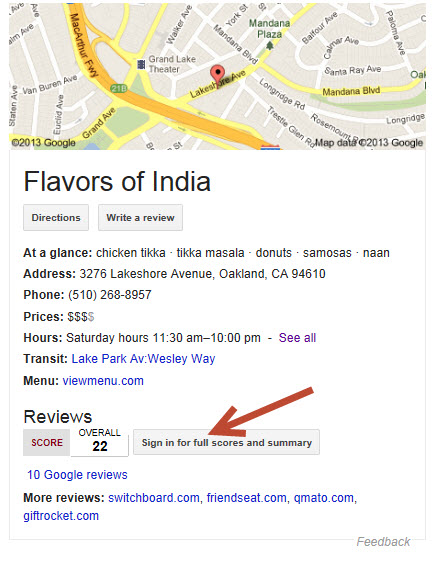
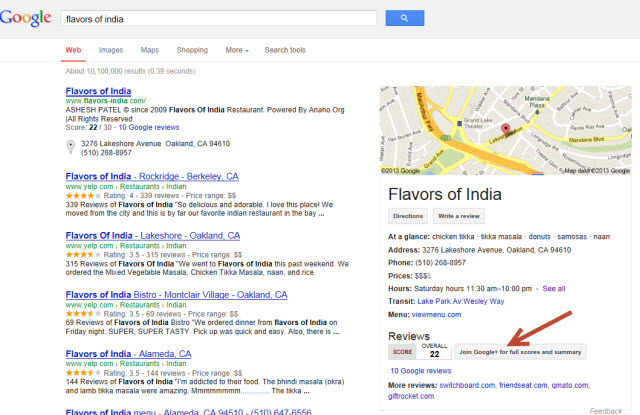
Information wants to be free.
Unless it is Google’s.
Then users want to be tracked and monetized.
Trademark Violations & Copyright Spam
A few years back Google gave themselves a pat on the back for ending relationships with “approximately 50,000 AdWords accounts for attempting to advertise counterfeit goods.”
How the problem grew to that scale before being addressed went unasked.
Last year Google announced a relevancy signal based on DMCA complaints (while exempting YouTube) & even nuked an AdSense publisher for linking to a torrent of his own ebook. Google sees a stray link, makes a presumption. If they are wrong and you have access to media channels then the issue might get fixed. But if you lack the ability to get coverage, you’re toast.
Years ago a study highlighted how Google’s AdSense & DoubleClick were the monetization engine for stolen content. Recently some USC researchers came to the same conclusion by looking at Google’s list of domains that saw the most DMCA requests against them. Upon hearing of the recent study, Google’s shady public relations team stated:
“To the extent [the study] suggests that Google ads are a major source of funds for major pirate sites, we believe it is mistaken,” a Google spokesperson said. “Over the past several years, we’ve taken a leadership role in this fight. The complexity of online advertising has led some to conclude, incorrectly, that the mere presence of any Google code on a site means financial support from Google.”
So Google intentionally avails their infrastructure to people they believe are engaged in criminal conduct (based on their own 50,000,000+ “valid” DMCA findings) and yet Google claims to have zero responsibility for those actions because Google may, in some cases, not get a direct taste in the revenues (only benefiting indirectly through increasing the operating costs of running a publishing business that is not partnered with Google).
A smaller company engaged in a similar operation might end up getting charged for the conduct of their partners. However, when Google’s ad code is in the page you are wrong to assume any relationship.
The above linked LA Times article also had the following quote in it:
“When our ads were running unbeknownst to us on these pirate sites, we had a serious problem with that,” said Gareth Hornberger, senior manager of global digital marketing for Levi’s. “We reached out to our global ad agency of record, OMD, and immediately had them remove them…. We made a point, moving forward, that we really need to take steps to avoid having these problems again.”
Through Google’s reality warping efforts the ad network, the ad agency, the publisher, and the advertiser are all entirely unaccountable for their own efforts & revenue streams. And it is not like Google or the large ad agencies lack the resources to deal with these issues, as there is some serious cash in these types of deals: “WPP, Google’s largest customer, increased its spending on Google by 25% in 2012, to about $2 billion.”
These multi-billion Dollar budgets are insufficient funds to police the associated activities. Whenever anything is mentioned in the media, mention system complexity & other forms of plausible deniability. When that falls short, outsource the blame onto a contractor, service provider, or rogue partner. Contrasting that behavior, the common peasant webmaster must proactively monitor the rest of the web to ensure he stays in the graces of his Lord Google.
DMCA Spam
You have to police your user generated content, or you risk your site being scored as spam. With that in mind, many big companies are now filing false DMCA takedown requests. Sites that receive DMCA complaints need to address them or risk being penalized. Businesses that send out bogus DMCA requests have no repercussions (until they are eventually hit with a class action lawsuit).
Remember how a while back Google mentioned their sophisticated duplication detection technology in YouTube?
There are over a million full movies on YouTube, according to YouTube!

The other thing that is outrageous is that if someone takes a video that is already on YouTube & re-uploads it again, Google will sometimes outrank the original video with the spam shag-n-republish.
In the below search result you can see that our video (the one with the Excel spreadsheet open) is listed in the SERPs 3 times.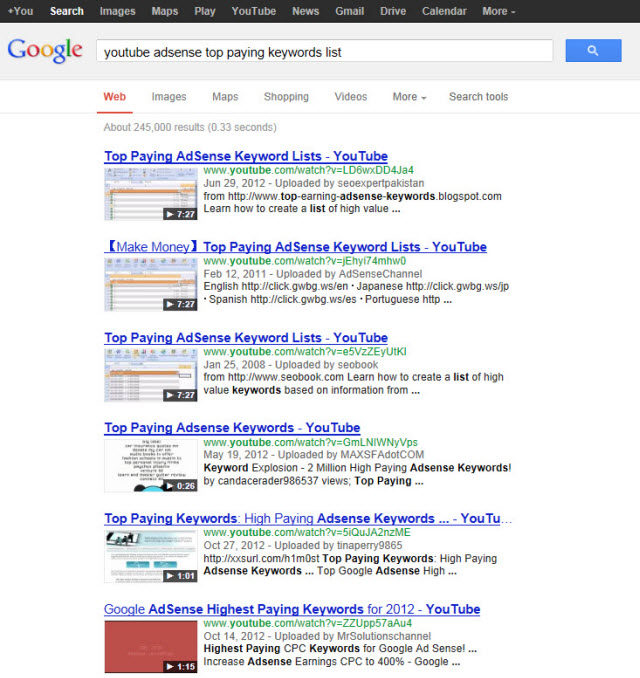
The version we uploaded has over a quarter million views, but ranks below the spam syndication version with under 100 views.
There are only 3 ways to describe how the above can happen:
- a negative ranking factor against our account
- horrible relevancy algorithms
- idiocy
I realize I could DMCA them, but why should I have to bear that additional cost when Google allegedly automatically solved this problem years ago?
Link Spam
Unlike sacrosanct ad code, if someone points spam links at your site, you are responsible for cleaning it up. The absurdity of this contrast is only further highlighted by the post Google did about cleaning up spam links, where one of the examples they highlighted publicly as link spam was not a person’s spam efforts, but rather a competitor’s sabotage efforts that worked so well that they were even publicly cited as being outrageous link spam.
It has been less than 3 months since Google launched their disavow tool, but since it’s launch some webmasters are already engaging in pre-negative SEO. That post had an interesting comment on it:
Well Mr Cutts, you have created a monster in Google now im afraid. Your video here http://www.youtube.com/watch?v=HWJUU-g5U_I says that with the new disavow tool makes negative SEO a mere nuisance.
Yet in your previous video about the diavow tool you say it can take months for links to be disavowed as google waits to crawl them???
In the meantime, the time lag makes it a little more than a “nuisance” don’t you think?
Where Does This Leave Us?
As Google keeps adding more advanced filters to their search engines & folding more usage data into their relevancy algorithms, they are essentially gutting small online businesses. As Google guts them, it was important to offer a counter message of inclusion. A WSJ articles mentioned that Google’s “get your business online” initiative was more effective at manipulating governmental officials than their other lobbying efforts. And that opinion was sourced from Google’s lobbyists:
Some Washington lobbyists, including those who have done work for Google, said that the Get Your Business Online effort has perhaps had more impact on federal lawmakers than any lobbying done on Capitol Hill.
Each of the additional junk time wasting tasks (eg: monitoring backlinks and proactively filtering them, managing inventory & cashflow while waiting for penalties tied to competitive sabotage to clear, filing DMCAs against Google properties when Google claims to have fixed the issue years ago, merging Google Places listings into Google+, etc.) Google foists onto webmasters who run small operations guarantees that a greater share of them will eventually get tripped up.
Not only will the algorithms be out of their reach, but so will consulting.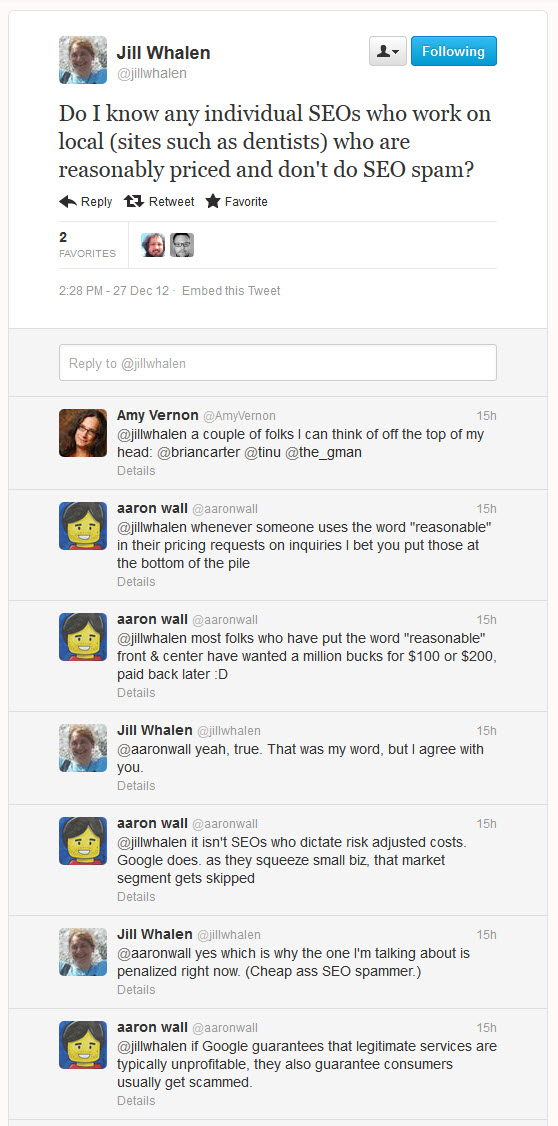
That algorithmic approach will also only feed into further “market for lemons” aspects as consultants skip the low margin, small budget, heavy lifting jobs and focus exclusively on servicing the companies which Google is biasing their “relevancy” algorithms to promote in order to taste a larger share of their ad budgets.
While chatting with a friend earlier today he had this to say:
Business is arbitrage. Any exchange not based in fraud is legitimate regardless of volume or medium. The mediums choose to delegitimize smaller players as a way to consolidate power.
Sadly most journalists are willfully ignorant of the above biases & literally nobody is comparing the above sorts of behaviors against each other. Most people inside the SEO industry also avoid the topic, because it is easier (& more profitable) to work with the elephants & attribute their success to your own efforts than it is highlight the holes in the official propaganda.
I mean, just look at all the great work David Naylor did for a smaller client here & Google still gave him the ole “screw you” in spite of doing just about everything possible within his control.
The linkbuilding tactics used by the SEO company on datalabel.co.uk were low quality, but the links were completely removed before a Reconsideration Request was filed. The MD’s commenting and directory submissions were done in good faith as ways to spread the word about his business. Despite a lengthy explanation to Google, a well-documented clean-up process, and eventually disavowing every link to the site, the domain has never recovered and still violates Google’s guidelines.
If you’ve removed or disavowed every link, and even rebuilt the site itself, where do you go from there?
Getting Your Pricing Right

How do you best determine the price to charge customers?
Do you look at the competition and price the same as they do? Undercut them a little? What happens if you do undercut them, then the customer still demands further discounts?
Pricing can be difficult to get right. We don’t know exactly how much the other party is prepared to pay, but we need customers in order to sustain and grow our businesses. So how do we ensure money is not left on the table, yet we still make the sale?
This guide looks at a few fundamental pricing techniques, ideas and strategies. We’ll look at how to avoid getting caught in the “race to the bottom” scenario of endless price cutting.
Market Price
Many people believe that when the buyer and seller agree on a price, then the market has arrived at the optimal price.
This is not strictly true.
What it means is the buyer and seller agreed on a price at a point in time. The seller might be desperate to land the next deal simply to make payroll for one more month. He almost feels sick when he accepted such a low offer, but he’ll worry about the fact he’s running into the red next month. Things will be better by then. Hopefully.
Meanwhile, the buyer now has an expectation she can always get discounts if she pushes hard enough. She makes a note to go even harder on price next month. After all, she got the distinct impression the seller had even more room to move.
Getting pricing right is about more than two parties agreeing on a price at a point in time. Pricing is also strategic. Pricing is about the long-term sustainability of a company.
But ultimately, pricing is about value.
What Do Your Customers Value?
Business is about providing and creating value.
You provide a valuable service or product the buyer can’t provide themselves. They then use your product or service, from which they derive, or add, value, and on-sell that value to their customers.
In order to set appropriate prices, you need to understand what your customers value.
How does one restaurant charge more than another in the same area? Why is that one restaurant always packed? It’s probably because they understand what people value. It might be the type of food they serve, or how they serve it, or they have a great view of the sea. Perhaps they do all three well. Their competitors do not.
They probably couldn’t charge what they do if they were two blocks back and overlooked a parking lot. The restaurant that is two blocks back with a view of the parking lot better figure out something else customers will value, or they are out of business.
The first step in determining pricing is to find out what your customers value, then adjust your service, where necessary, to provide that value. In this way, pricing can be seen as intrinsically linked to your positioning strategy. Perhaps customers value a free and easy returns policy (convenience) over price. Perhaps they want individual items packaged together (individual commodity tools packaged together in a stylish box becomes a toolbox gift idea). Perhaps they didn’t want to buy a handbag at all, they just wanted to rent one (bagborroworsteal.com).
The aim of value based pricing is to shift the focus from price to questions of value.
Move To Value Based Pricing
Value based pricing means pricing based on the value you deliver to a customer.
You figure out the value of your product to to the customer, then take a slice of that value to arrive at your price. Your production cost might be $10 per unit, but if each unit provides $1000 worth of value to your customer, then $500 might be a fair price to charge.
In order to price based on value, you need to understand exactly what your customer values and your point of differentiation to your competitors. Your value proposition combined with your price point must be differentiated. After all, it would be difficult to price at $500 if your competitors were pricing at $300, and both provide the same value to the customer.
The Problem With Cost-Plus Pricing
Cost-plus pricing is when you figure out your total costs, then add a percentage, which is your profit.
It may cost you $X to produce and sell a service and make a profit, but if buyers don’t value what you offer, then your price will always be too high. Also, if you use cost-plus pricing and your customer derives considerable value from what you offer, then the customer may love you, but you’re leaving a lot of money on the table. You could be making more profit and using that to invest in your business.
Commodity
But what if you’re selling the same stuff as everyone else?
The internet can be a hostile place for commodity sellers as price comparisons are only a click away. This type of environment works well for big players who can compete on price when selling commodity items, yet still make money off thin margins and fat volume.
Low-volume competitors would be wise to consider a shift of focus to value-added services, such as higher service levels, if they can’t compete on price.
Best Interests Of The Customer
It might be in the best interests of your customer to pay higher prices if this means the value they seek can be reliably delivered on an on-going basis. If an industry is run into the ground due to price cutting, then where will the customers get the services they really do value in future?
Part of the process of getting pricing right is customer education i.e. ensure they can see the value. Demonstrate what is involved in arriving at your price points. For example, who pays $70 for an ipad cover when you can get them for $10?
People do if it’s a DODOcase.
DODOcase demonstrate what goes into producing their cases. They’re selling the experience and craft values as much as they are selling the product itself, so this is also a way to differentiate the product. Their customers value the idea of supporting artisan crafts, which is part of the value they’re paying for, but this wouldn’t be obvious if their customers were comparing one case against another on price alone. DodoCase have shifted the debate away from price and made it about value. Well, values.
So, customers like to see what goes into the product. It helps them determine value. Transparency is a big part of pricing, particularly high-end pricing. To be credible and survive scrutiny, high end pricing has to to be accountable and make sense.
Knowing what price to set is knowing what the customer values, or can be made to see value where previously they saw none. Always ask questions and refine your offer based on the answers. Do you need to change how you present your existing offers in order to demonstrate value? Do you need to change your offerings to meet the market?
Pricing Strategies
Let’s look at three of the most common pricing strategies.
Skim Pricing
Skim pricing is when you set a higher price than your competitors.
In order to set pricing in this way, your customers need to perceive that your offer provides them with greater benefits than they will find elsewhere. Apple use skim pricing.
Customers perceive that Apple products are superior to the competitors, so it is therefore worth paying a premium. Whether this is objectively true or not is irrelevant – so long as the customers perceive that value, then it exists. This justifies the higher price. It could be argued the customer also gains social value by paying a high price, as they have something exclusive.
In order to skim price, you need to offer something the customer can’t easily get elsewhere. The customer must place a high value upon your service.
Consultants with proven reputations can use skim pricing, although maintaining a reputation over and above everyone else in crowded, maturing markets can be difficult. Where there are high margins, competitors will soon enter the space offering similar value.
The benefit of skim pricing is that you get to pick off the price-insensitive top-of-the-market clients. Who wouldn’t want this situation?
The downside is that other competitors can move into the price gap, slightly beneath the skim level, then bump up the value they offer in order to challenge the skim price competitor. They may create greater efficiencies, which means their profit margins are the same, if not higher. The value proposition to the customer remains strong, yet they undercut the leader on price.
It is only so long before the leader is forced to drop prices, refine their value proposition, or collapse. Skim market pricing can lead to a rapid erosion of market share if the leader does not stay well ahead of the market in terms of providing value. This happened to Apple in the 1980’s, and we might be seeing this again on tablet devices.
Analysts expressed concerns that Apple risked losing ground to Nokia smartphones in China, while failing to keep pace with Google in the tablets market…..Traders were also spooked by a report from research firm IDC forecasting that Apple’s share of the tablet market will slip to 53.8pc this year from 56.3pc in 2011, while Google’s share will increase to 42.7pc from 39.8pc.
It added that Apple’s tablet share will slip below 50pc by 2016, as total global tablet sales more than double to nearly 283m units in four years as consumers increasingly opt for them rather than personal computers
Apple could skim price when they were early to market with a product no one else had i.e. iphones and iPads. However, as competitors catch up, and make similar products at lower prices, then Apple’s current pricing strategy may hit problems. Apple get around this, to some extent, by using versioning.
Neutral Pricing
Neutral pricing is when you set your pricing at a comparable level to your competitors.
You’d use this pricing method if you want customers to consider other aspects, besides price, when they contemplate a purchase i.e. they can get SEO software tools from company X, but compay Y offers the same tools but with extra support. Neither company wants to engage in a price war, so they will keep layering on more value in order to make their offer more compelling.
If these companies started cutting prices in order to compete, then they’ve got a “race to the bottom” problem. If customers don’t want to pay for the services they provide, that’s fine, but the customer is unlikely to get them somewhere else, so long as these services cost a certain amount to provide. In so doing, this market sector retains value for all players, so long as they deliver genuine value to customers.
This is an especially good pricing model to use if you want your customers to focus on the features of the offer. If you offer more features for the same price, you will likely win.
Penetration Pricing
Penetration pricing is when you set a relatively low initial entry price, hoping people will switch from a higher priced vendor.
Companies looking to gain market share tend to use penetration pricing. Penetration pricing has been a popular pricing model for internet companies, reasoning if they build the audience, they’ll figure out how to make money later. So long as customers place some value on the service, then the company should build their customer base quickly.
There are obvious problems with acquiring customers on a low-price basis. The customers you land are price-sensitive and will likely become non-customers the minute someone else lowers their price, or you increase your price.
You’re still vulnerable to competitors who offer something better, who are more efficient, or have more venture capital to blow through. Even if you set a low price, they can still undercut you.
There’s More To Price Than Price
Some buyers accept that buying on price alone may be a poor strategy.
In the example I gave earlier, the buyer is screwing down the vulnerable vendor to the point where he may go out of business. Let’s say she derives significant value from his company that she can’t readily get somewhere else. Perhaps he’s been a supplier to the firm at which she works for a few years and he really knows their systems. Any new supplier will have to spend time coming up to speed, and this could affect the productivity of our buyer.
The buyer likely has a switching cost.
As a seller, he should have made more effort to understand his value to the buyer, and be able to articulate it in such a way that she saw it, too. A buyer who understands long-term value is less likely to focus exclusively on price. It is to their advantage to nurture the relationship for mutual benefit.
Many buyers crave highly functional partnerships with vendors. If a search marketing vendor invests significant effort to add value to the company to which they supply services, then it is less likely they’ll be replaced on price alone. The longer the vendor works with the company, and the more success they bring to that company, the less likely they are to be replaced.
Sometimes, these customers will still try to play you. They will try to get a lower price. They know they need what you’ve got, they’re happy with the relationship, but they still want to see if they can get you to move on price. They may say they are reviewing arrangements. They may put you up against other suppliers in the form of a, RFP. Some of those suppliers will bid low amounts, which the buyer will then put pressure on you to match.
The way to counter this is to know your value relative to the competition. You can always match with a lower price, just so long as the customer accepts that you will be reducing your features to match those on offer from your competitors. The buyer will either go for it it, meaning price really was an issue, or accept your higher price, meaning value was the main issue. More on this shortly.
You must also understand your bottom line and stick to it. Some customers simply aren’t worth having. If you land them, and make little money or even a loss, with hopes you’ll raise prices later – what happens? The minute you raise prices they go back out to tender again. They’ll just find another low-priced bid.
This is what happens to vendors who can’t differentiate on value.
Make Your Offering More Flexible
If we don’t offer what the market values, then pricing strategies won’t help much.
Businesses must innovate in order to capture new markets and meet demand. Create new products and services. Relying on price increases alone to drive growth is unlikely to work unless people can’t get what you offer anywhere else, and what you’re offering remains in high demand.
One solution is to provide multiple products or service levels. If some buyers are genuinely price oriented, that’s fine, but they get the lower service level. Contrary to popular opinion, most buyers are actually value oriented, and will choose higher value services, so long as they perceive genuine value, or can be shown that by using you then profitability will be increased.
The “Choice Of Three” Strategy
One price methodology involves creating three levels. One low priced offer, one mid priced offer, and one high priced offer. Many buyers, when faced with the “choice of three” will pick the middle offer.
Appliance stores often price this way. They’ll stock two or three very high end, expensive refrigerators. They’ll also stock some basic, cheap refrigerators. Most customers will use those two points as price guides, and buy somewhere in the middle. If the store didn’t carry the high end refrigerators for the purposes of comparison, then the mid-range refrigerators become the highest price offering, and people’s price expectations will adjust – downwards – accordingly. The middle is seen as the “sensible” choice.
So, try pricing your top level offering at skim pricing levels. Include all the bells-and-whistles. Most people won’t pay this price, but between this and the lowest price offer, it helps set buyer expectations. The middle bundle is actually your full price offering, possibly neutrally priced vs competitors, but buyers may see it as the sensible middle ground compromise. Funnily enough, you’ll be surprised at how many people still go for the bells-and-whistle option!
Getting Differentiation Right
Differentiation between bundles (product or service levels) also helps you identify price buyers and value buyers. For this to work, you need to create clear and logical demarcation between offerings, otherwise customers may try to pay the low price, but get you to include high price features.
In service businesses, one way of preventing a customer from trying to get the expensive bundle for the low-cost price is to be transparent about your pricing. Yes, they can have the extras, but they involve X more hours. How many of those hours do they wish to purchase? This is transparent. It makes logical sense. There is no arguing with this position, as everyone understands that time is money.
However you do it, ensure that the transition between price points makes sense. The transition can’t appear arbitrary. The more expensive bundle is more expensive because it has more input costs, demonstrably delivers more value, or both.
Companies who get this wrong typically create arbitrary price settings between bundles. There isn’t a lot of distinction in terms of value between the jumps, or the core offering is not included at the low level.
Companies typically put their core offerings in every package, and add “nice-to-have” features at higher price levels. All customers will want the core offering. Price sensitive customers will settle for the core offering and nothing else. Value customers will likely add the nice-to-haves so long as these extras provide the value they seek.
Once a customer is on board at the low-value level, then they may wish to add extras later, once value has been demonstrated. Many software-as-a-service companies use this pricing strategy. The core product, if it is commodity, is often free. This hooks you into using it, but doesn’t cost the company much to deliver. It’s a loss leader sales-tool.
If you want to use it more – say, add more people or use advanced features – then you move up the scale to higher price points. It’s very difficult for competitors to compete with this strategy, because the core offering is free and the switching cost, whilst possibly not high, still exists. In order to compete, competitors must offer better services or more features, and probably lower prices. This is also the reason the first-mover needs to constantly innovate i.e. add and enhance services in order to stay ahead of the game.
One way to make the middle tier offering even more compelling is to load it with features vs the entry-price option.
The low price offering provides the core product and nothing else. The mid-priced offering, however, is packed full of features. The buyer may not even use many of the features, but they reason that there appears to be a lot more value at that level than the entry level, so opt for the higher price. This is most effective when the low-price option and mid-price option are reasonably close. You often see this approach used with “but wait, there’s more!” offers. They keep loading on the features, so the buyer perceives more and more value.
Pricing Strategies For Software & Information Products
The very first copy of a Windows release costs billions. The customer pays around $40 for that first copy.
Most of the costs in software development and information products are upfront, but the advantage of these types of businesses is that the cost of producing each additional copy is marginal. Microsoft can produce many millions of copies for a few cents each. How does a software business, or information product, go about pricing a product?
Typically, these companies set a low price in order to build momentum, thus adopting a penetration approach. Once the user is hooked in, they then add additional higher value services on top. A good example of this type of strategy is used by the likes of WordPress and Silverstripe. The core product is free, but if customers want enterprise hosting, support of custom development, then they pay a fee.
Negotiating
It can be pretty difficult to stick to your guns, especially if you really need the business.
However, pricing is really a question of value. So long as you’re certain you provide the customer with value they can’t get elsewhere, then you’re in a strong negotiating position.
Know what the customer values. If the customer values the same things from another competitor, and you can provide no added value, then you are vulnerable on price. However, if you can identify something you have the buyer values over the others, then that is your trump card.
You demonstrate your value to the customer. If the customer still refuses to see it, and still screws you down on price, then you can play your trump card. Sure, they can have the lower price, but they can’t have the high value aspects of your service. They can have the basic core service. You could still make the sale, but you should remove valuable features.
For example, service level agreements tend to be structured at various levels and price points. If the customer wants immediate attention 24/7, then they pay top dollar. If they don’t care about receiving immediate attention, that’s fine – they pay the lower price. Give the customer options, demarcated by obvious value, and they can decide for themselves. If you know they really need high value service X, and can’t get it from somewhere else, then you’ll force them to buy on value and drop their low price demand.
As customers, we value sellers differently, unless we’re buying pure commodity. Yet your customers might try to convey the idea that sellers are all the same to them, it’s only about price.
It seldom is. Find out what they value most.
Be Flexible
If your primary purpose is to gain exposure in a market, it will be useful to acquire customers who can help spread your message. I know of one SEO service provider who started out by providing five large companies free search marketing services for a year simply so the SEO service provider could be associated with those companies, thereby gaining credibility in the market as a “leading supplier”. They then skim priced for 2-nd tier companies, which were their real targets. The twist here is that the seller places a value on the buyer.
Pricing changes can depend on where in the product life-cycle you are, and what your competitors are doing. If you are the market leader, and using skim pricing, but you competitors overtake you, and offer more value, then it might be time to rethink your pricing. A shift to neutral pricing might be in order, as well as a revision of the offer to match competitors.
If new entrants move into the market and offer low prices, then adopting a penetration strategy might be useful in order to get rid of them i.e. make part of your offering low cost or free. This is a strategy that has been used by airlines facing threats from low-cost competitors. They start up their own subsidiaries and use these to starve the competitors out of the market as a rear-guard pricing strategy.
Know Your Relative Value
Ensure you’re differentiated. List all the products, services and activities you offer. Make a note of what your value is to the customer next to each product or service.
Next, identify your competitors. Identify those who are similar, those who are better and those who are worse. Evaluate their offerings. What are their value propositions? If you can, find out their price points. Where would a customer see value in their offering?
List your offerings in terms of value i.e. High value, medium, and low value. Then grade the level of differentiation when compared with your competitors. i.e. high differentiated, similar, or weaker. Anything high value and differentiated can likely be skim priced, anything similar can be neutrally priced, and anything low consider penetration pricing, or dropping.
Review your margins. Is it even worth offering low priced services? Should you be focusing on delivering more features at a higher pricing level? Should you be moving to a highly differentiated offering? Only you know the answer to these questions, but it’s a quick strategic pricing assessment well worth doing.
But what, after all is said and done, the customer still wants a lower price?
Fire Customers
But what if the customer still wants to pay the lowest price, even after you’ve made certain they value what you provide?
Some customers simply aren’t profitable. What is worse, they take up your time, meaning you’ve got less time to dedicate to your profitable customers.
So cut them loose.
There is a rule called the 20-255 rule. It’s a revision of the 80-20 rule, and it goes like this:
In an article published in the Harvard Business Review, Cooper and Kaplan reported the astonishing case of a heating wire company which analyzed its customer profitability and discovered that the famous 20 – 80 rule, which would suggest that 80% of profits came from 20% of customers, had to be revised: “A 20 – 225 rule was actually operating: 20% of customers were generating 225% of profits. The middle 70% of customers were hovering around the break-even point, and 10% of customers were losing 125% of profits
Make a list of your customers from most profitable to least. Contact the least profitable clients and try to renegotiate terms. Some will agree to this, others won’t.
Cut those who don’t. This instantly increases your profits and serves as a reminder not to sell to people in future who don’t adequately value what you do.
I hope this article has provided some food for thought on pricing strategy. Pricing is a huge topic, so can’t be covered in one article, so if you’ve got some pricing strategies and philosophies you’ve found useful, please add them to the comments!
References & Further Reading:
- Pricing With Confidence by Reed Holden. This is a great book on pricing and the inspiration for some of the ideas presented in this article
- Price Theory by David D Friedman
- The Art Of Pricing by Rafi Mohammed
- The Strategy and Tactics of Pricing: A Guide to Growing More Profitably by Thomas Nagle
Is Google Concerned About Amazon Eating Their Lunch?
Leveling The Playing Field
When monopolies state that they want to “level the playing field” it should be cause for concern.
Groupon is a great example of how this works. After they turned down Google’s buyout offer, Google responded by…
- adding offers ads directly in the search results
- partnering with over a dozen competitors in the space
- acquisitions that would later lead to layoffs.
The same deal is slowly progressing in the cell phone market: “we are using compatibility as a club to make them do things we want.”
Leveling Shopping Search
Ahead of the Penguin update Google claimed that they wanted to “level the playing field.” Now that Google shopping has converted into a pay-to-play format & Amazon.com has opted out of participation, Google once again claims that they want to “level the playing field”:
“We are trying to provide a level playing field for retailers,” [Google’s VP of Shopping Sameer Samat] said, adding that there are some companies that have managed to do both tech and retail well. “How’s the rest of the retail world going to hit that bar?”
This quote is particularly disingenuous. For years you could win in search with a niche site by being more focused, having higher quality content & more in-depth reviews. But now even some fairly large sites are getting flushed down the ranking toilet while the biggest sites that syndicate their data displace them (see this graph for an example, as Pricegrabber is the primary source for Yahoo! Shopping).
Some may make the argument that a business is illegitimate if it is excessively focused on search and has few other distribution channels, but if building those other channels causes your own site to get filtered out as duplicate content, all you are doing is trading one risky relationship for another. When it comes time to re-negotiate the partnerships in a couple years look for the partner to take a pound of flesh on that deal.

How Google Drives Businesses to Amazon, eBay & Other Platforms
Google has spent much of the past couple years scrubbing smaller ecommerce sites off the web via the Panda & Penguin updates. Now if small online merchants want an opportunity to engage in Google’s search ecosystem they have a couple options:
- Ignore it: flat out ignore search until they build a huge brand (it’s worth noting that branding is a higher level function & deep brand investment is too cost intensive for many small niche businesses)
- Join The Circus: jump through an endless series of hoops, minimizing their product pages & re-configuring their shopping cart
- PPC: operate at or slightly above the level of a non-functional thin phishing website & pay Google by the click via their new paid inclusion program
- Ride on a 3rd Party Platform: sell on one of the larger platforms that Google is biasing their algorithms toward & hope that the platform doesn’t cut you out of the loop.
Ignoring search isn’t a lasting option, some of the PPC costs won’t back out for smaller businesses that lack a broad catalog to do repeat sales against to lift lifetime customer value, SEO is getting prohibitively expensive & uncertain. Of these options, a good number of small online merchants are now choosing #4.
Operating an ecommerce store is hard. You have to deal with…
- sourcing & managing inventory
- managing employees
- technical / software issues
- content creation
- marketing
- credit card fraud
- customer service
- shipping
Some services help to minimize the pain in many of these areas, but just like people do showrooming offline many also do it online. And one of the biggest incremental costs added to ecommerce over the past couple years has been SEO.
Google’s Barrier to Entry Destroys the Diversity of Online Businesses
How are the smaller merchants to compete with larger ones? Well, for starters, there are some obvious points of influence in the market that Google could address…
- time spent worrying about Penguin or Panda is time that is not spent on differentiating your offering or building new products & services
- time spent modifying the source code of your shopping cart to minimize pagecount & consolidate products (and various other “learn PHP on the side” work) is not spent on creating more in-depth editorial
- time switching carts to one that has the newly needed features (for GoogleBot and ONLY GoogleBot) & aligning your redirects is not spent on outreach and media relations
- time spent disavowing links that a competitor built into your site is not spent on building new partnerships & other distribution channels outside of search
Ecosystem instability taxes small businesses more than larger ones as they…
- don’t have as generous of terms with pushing items back on the supplier
- often get products at higher price-points due to delivering smaller volumes & not being “bigger than Japan”
- lack the offline sales channels to move product through when an animal from the plex hits their sites
- lack large capital reserves & generally don’t have credit on as favorable terms
- can’t bribe governments for special deals & can’t rely on government subsidies for most of their profits
The presumption that size = quality is false. A fact which Google only recognizes when it hits their own bottom line.
Anybody Could Have Saw This Coming
About a half-year ago we had a blog post about ‘Branding & The Cycle‘ which stated:
algorithmically brand emphasis will peak in the next year or two as Google comes to appreciate that they have excessively consolidated some markets and made it too hard for themselves to break into those markets. (Recall how Google came up with their QDF algorithm only *after* Google Finance wasn’t able to rank). At that point in time Google will push their own verticals more aggressively & launch some aggressive public relations campaigns about helping small businesses succeed online.
Since that point in time Amazon has made so many great moves to combat Google:
- opting out of participating in Google’s PLAs
- creating brand-specific pages hosted on Amazon.com managed by 3rd party brands & tying into social channels
- quietly fleshing out their own ad network
All of that is on top of creating the Kindle Fire, gaining content streaming deals & their existing strong positions in books and e-commerce.
It is unsurprising to see Google mentioning the need to “level the playing field.” They realize that Amazon benefits from many of the same network effects that Google does & now that Amazon is leveraging their position atop e-commerce to get into the online ads game, Google feels the need to mix things up.
If Google was worried about book searches happening on Amazon, how much more worried might they be about a distributed ad network built on Amazon’s data?
Said IgnitionOne CEO Will Margiloff: “I’ve always believed that the best data is conversion data. Who has more conversion data in e-commerce than Amazon?”
“The truth is that they have a singular amount of data that nobody else can touch,” said Jonathan Adams, iCrossing’s U.S. media lead. “Search behavior is not the same as conversion data. These guys have been watching you buy things for … years.”
…
Amazon also has an opportunity to shift up the funnel, to go after demand-generation ad budgets (i.e. branding dollars) by using its audience data to package targeting segments. It’s easy to imagine these segments as hybrids of Google’s intent-based audience pools and Facebook’s interest-based ones.
Google is in a sticky spot with product search. As they aim to increase monetization by displacing the organic result set they also lose what differentiates them from other online shopping options. If they just list big box then users will learn to pick their favorite and cut Google out of the loop. Many shoppers have been trained to start at Amazon.com even before Google began polluting their results with paid inclusion:
Research firm Forrester reported that 30 percent of U.S. online shoppers in the third quarter began researching their purchase on Amazon.com, compared with 13 percent who started on a search engine such as Google – a reversal from two years earlier when search engines were more popular starting points.
Who will Google partner with in their attempt to disrupt Amazon? Smaller businesses, larger corporations, or a mix of both? Can they succeed? Thoughts?
How to Obfuscate And Misdirect an Algo Update
Sharing is caring!
Please share :)
Embed code is here.
If you find the following a bit hard to read due to font size, a wider version is located here.
Categories: google
The ‘Scam’ Site That Never Launched
(A case study in being PRE negatively seo’ed)
Well it has been a fun year in search. Having had various sites that I thought were quality, completely burnt by Google since they started with the Penguins and Pandas and other penalties, I thought i would try something that I KNEW Google would love….. Something dare I say would be “bulletproof.” Something I could go to bed, knowing it would be there the next day in Google’s loving arms. Something I could focus on and be proud of.
Something I could focus on and be proud of.
Enter www.buymycar.com, an idea I had wanted to do for some time, where people list a car and it gets sent to a network of dealers who bid on it from a secure area. A simple idea but FAR from simple to implement.
Notes I made prior to launch to please Google and to give it a fighting chance were:
- To have an actual service and not to be an affiliate. Google crushed my affiliate sites and we know they are not fond of them as they want to be the only affiliate I think.
- To make sure the content was of a high quality. I took this so seriously that we actually made a point of linking out to direct competition where it helped to do so. This was almost physically painful to do! But I thought I would start as I meant to go on. I remember paying the content guy that helps me, triple his normal fee to go above and beyond normal research for the articles in our “sell my car” and “value my car” sections.
- To make the site socially likeable. I wanted something that people would share and as such to sacrifice profits in the short term to get it established.
- To give Google the things it loves on-site. Speed testing, webmaster tools error checking (even got a little well done from Google for having no errors, bless), user testing, sitemaps for big G to find our content more easily, fast hosting, letting it have full access with analytics…
- TO NEVER, EVER UNDER ANY CIRCUMSTANCES PAY FOR A LINK. Yes, I figured I would put all the investment into the site and content this time. If it went how I had hoped perhaps I could find the holy grail where site’s link to us willingly without a financial incentive! A grail I had been chasing for some years. Could people really link out without being paid? I had once heard a rumour it was possible and I wanted to investigate it……
Satisfied I had ticked all the boxes from hours of Matt Cutts video’s and Google guidelines documents, I went to work and stopped SEO on all my smaller sites that were out of favour. I was enjoying building what I had hoped would be a useful site and kicked myself for not having done so sooner. I also thanked Google mentally for being smart enough now to reward better sites.
Fast forward 4 months of testing and re testing and signing up car dealers across the country and I decided to do a cursory check to see if anyone had liked what I was building and linked to it. I put my site into ahrefs.com and to my surprise, 13,208 sites had!! What was also nice was that all of them had used the anchor text “Buy My Car Scam” and had been so kind as to give me worldwide exposure on .ru, .br and .fr sites in blog comments amongst others. 
In seriousness, this was absolutely devastating to see.
A worried competitor had obviously decided I was a threat and to nip my site in the bud with Google and attack it before it had even fully started. The live launch date was scheduled for January 7th, 2013! I was aware of negative SEO from other sites I had lost but not in advance of actually having any traffic or rankings. Now I was faced with death by Google rankings to look forward to before it had any rankings, add to that my site being cited as a scam across the Internet before it launched!
My options were immediately as follows:
- Go back and nuke the likely candidates in Google who had sabotaged me. Not really an option as I think it is the lowest of the low.
- Start trying to contact 13,000+ link owners to ask for the links to be removed. When I am heavily invested in this project anyway and have a deadline to reach, this was not an option. Also, Xrummer, Scrapebox or other automated tools could send another 13,000 just as easily in hours for me to deal with.
- Disavow links with Google. To download all the links, disavow them all and hope that Google would show me mercy in the few months Matt Cutts said it takes to get to them all removed.
- Give up the project. Radical as this may sound, it did go through my mind as organic traffic was a big part of my business plan. Thankfully I was talked out of it and it would be “letting them win.”
I opted for number 3, the disavow method but wondered what would happen if I kept being sent 10’s of thousands more links and how a new site can actually have any protection from this? To set back a site months in its early stages is devastating to a new on-line business. To be in a climate where it is done prior to launch is ridiculous. 
Had I fired back at future competitors as many suggested I did, there would be a knock on effect that makes me wonder if in the months to come, everyone will be doing it to each other as routine. Having been in SEO for years I always knew it was possible to sabotage sites but never thought it would become so common and before they even ranked!
Robert Prime is a self employed web developer based in East Sussex, England. You can follow him on Twitter at @RobertPrime.
Our Looking into the Crystal Ball of 2013 Predications Post
It’s hard to believe it is the middle of December and a whole year has blown by. To say 2012 was an interesting year would be an understatement, one thing is for sure, it was never dull!
Some of the SEOBook Moderators and I want to share what we feel will be hot (or not) in 2013, we have a diverse mixture of topics, opinions and practical marketing tactics for you to consider. First up is our fearless leader Aaron Wall!
Aaron Wall
Google Verticals
I believe we’ll see additional Google verticals launched (soon) and they’ll be added to the organic search listings. My guess is that (now that the advisor ad units are below AdWords) we can expect to see Google seriously step into education & insurance next year. I also expect them to vastly expand their automotive category in 2013.
SEO’s Move On
Tired by the pace of change & instability in the search ecosystem (along with the “2 books of guidelines” approach of enforcement in the search ecosystem), many people who are known as SEOs will move on in 2013. Many of these will be via acquisitions, and many more will be due to people simply hanging it up & moving on.
Rebranding Away From SEO
A company in the SEO niche that has long been known as an SEO company will rebrand away from the term SEO. After that happens, that will lead to a further polarization of public discourse (where most anything that is effective and profitable gets branded as being spam), only further fueling #2.
Geordie Carswell from Clearly Canadian (err, we mean here)
Adwords
Regarding Adwords, Google will aggressively dial up Quality Scores on keywords that have languished in activity due to low-QS but haven’t yet been deleted by advertisers. They seem to have given Quality Scores a bump across the board in Q4, bringing in unexpected increases in traffic and cost to advertisers who weren’t aware ‘dormant’ keywords were even still in their accounts. It’s a fantastic revenue generator almost on-demand for Google if the quarterly numbers aren’t looking good.
Peter DaVanzo (aka Kiwi)
Building Brand
More focus on building brands i.e. the people behind the site, their story, their history.
This is to encourage higher levels of engagement, leading to increased loyalty. Making the most of the traffic we already have
Eric Covino (aka vanillacoke)
SEO Diversifies
I think the industry will continue to become more divisive as more people either get out or go more underground and those that continue to remain overly-public will continue to invent language to serve their own commercial purposes while chastising those who do not fall in line; labeling these folks as spammers and bad for the industry in desperate attempts at differentiation so they can continue to try and sell to brands and the lower part of the consumer pyramid (read: mindless sheep)
There will be exceptions where the company will do and probably continue to do really well, but largely those who try and move from being pure SEO agencies to full service [insert new term here] ad-type agencies will fail at delivering real value to their clients. These people will resort to more outing and public spam report filings despite their amusing posts on how they are “different” and “clean”. I believe this will spawn a return of enterprise-level SEO services to competent SEO’s and SEO firms but not to the “point, link, report ranking agencies”. I believe the latter will die a faster death in 2013. Technical proficiency in SEO will become more and more valuable as well, especially if enterprise-level SEO returns as I think it will.
SEO Pricing Structures Will Change
A fractured search landscape where data is harder to come by (not provided, rank checking issues, mobile disruption) in addition to frequent algo shifts and confusion with local rankings will make low-cost SEO much harder to justify and measure, especially in the local area. These issues, coupled with the rising cost of doing business online, will make low to even moderate budget SEO (really low 4 figures or high 3 figures per month) difficult to provide effectively and profitably over a sustained period of time.
The closing window will stay somewhat wide for those that stay around and can afford to take down the margins a bit on some projects. This would be a result of a fairy sizable exodus from the industry as a whole (the self-SEO crowd, for lack of a better term)
Debra Mastaler from Alliance Link
Mobile Applications (apps) and Content for Them
Doesn’t it seem like everyone has been talking about the mobile explosion for years now? I’m jumping on that bandwagon but from a slightly different angle.
If your product lends itself to having an app, I’d urge you to get one started, even if it’s a basic program or you have to partner with someone to make it happen. Recent statistics show there are one billion smart phone users and five billion mobile phone users in the world; being seen on mobile devices is no longer a novelty when those kinds of numbers are involved. So how do you get your content in front of mobile users?
For Android fans, you can turn your best content into an Android App by using tools like AppsGeyser. Their simple three step process allows you to create apps by using content you’ve already written or showcasing a widget you have in service. If you have evergreen content or a popular widget a lot of people download, create an app to keep them one click away and receiving fresh streams of content from your site.
If you’re in a space already filled with apps or can’t create one, consider creating unique content to go with what is out there. For example, novelist Robin Sloan created an iPhone app for “tappable” content. To move the story along, you tap the screen to the next page. It is a super simple concept that has exploded over the Internet. (For more tappable story examples visit here) creating this kind of content sets you apart from your competitors and provides you with a fresh news angle to pitch the media.
If you do create an app, add it to popular download sites like iTunes but make it exclusively available on your website first.
(Tip: Search on “content for iPad” for ideas on creating unique content for tablets and then use the suggestions above to promote them)
Video
OK, more impressive stats to start this section:
“In general, we know that 800 million people around the world use YouTube each month, a stat that I’m sure we’re going to see increase to a billion soon. And nearly all 100 of AdAge’s top 100 advertisers have run ad campaigns on YouTube and Google Display Network–98 in fact.”
There is the word “billion” again! But there’s more and it comes appropriately, right after my pitch for mobile apps:
…”mobile access, which gets over 600 million views a day, tripled in 2011.”
They are talking about access to YouTube here, that’s an astonishing number of views per day. Add to it video results have a tendency to:
- be shown in the first fold of the organic search results (so annoying)
- help make a site “sticky”
- are easily passed around social media sites “like” Facebook
Three sound reasons why you should be involved in making and promoting video in 2013. Since video works well on smartphones, I’d focus equal resources on creating, optimizing and promoting video and written content in 2013. Check out what top brands are doing on YouTube for promotion ideas, where they’re pimping their vids and how. (And an app to play them on, see above) J
Content Partnerships and Variety is a Search Spice
I think everyone will agree using “content” is the tactic du jour when it comes to attracting links and traffic. I expect the trend to continue and with good reason, online news outlets, magazines and topical blogs are as eager to run good content as webmasters are to place it. Finding good outlets will be key, when you do, consider developing a “content partnership” with a set number of sites and negotiate to place more than written content.
What is a content partnership? In a nutshell it’s an exclusive commitment you have to provide content to a set number of sites. You find a handful of authoritative sites to write for and negotiate the amount and type of content you want to submit. They in turn, get a steady stream of well-produced content and build a solid editorial team. Win-win!
In a perfect world it’s best to be the only one writing on a topic but we all know perfection is hard to achieve. In that case, zero in on what you want to write about and approach an outlet with a narrow focus. For example, instead of saying “I’ll write all your baby food articles”, say, “I’ll provide articles, podcasts and videos on natural and organic baby food”. You are much more likely to get what you want if you agree to create content on a specific subject rather than a broad or general topic.
Authentic networking will be key in the future, lock down your sources early and take advantage of the popularity boost you’ll receive associating with highly visible, authority sites in your niche. Use a variety of content methods, the public doesn’t live on written content alone. Video, news and images dominate universal search results; create this type of content so you improve your chances of being seen especially if brands dominate your sector. (So annoying!)
Will Spencer from Tech FAQ
The Value of Links
With Google penalizing obviously generated links instead of simply ignoring them, the value of less-obviously generated links will continue to rise. This will result in higher prices for paid links and an improved return on investment for those links. It will also bring link trading back in vogue, particularly with three-way linking.
We’ll be paying more (or charging more) for links than ever before. With most links being discounted or penalized, it will require fewer links to rank — but those links will have to be acquired at higher prices.
Anita Campbell from Small Business Trends
Website Design Goes Pinterest
We are seeing more websites and blogs designed and displayed a la Pinterest. Content appears in visual boxes with limited text. With that comes a lot more of the infinite scroll – the page that never ends. The new Mashable design is an example. It is hard to tell whether this is a short term fad or a long term trend – but when you have an infinite scrolling page the footer often goes. So all those footer links – well, many may go away.
Social Media Gets the Blender Effect
Social media aggregators are popping up like mushrooms. Tools like Rebelmouse, Scoop.it, Paper.li and a dozen more grab Facebook posts, tweets, retweets and/or blog posts, and mix them all together in a visually appealing presentation that you can embed on your own domain. Some of these tools are not so hot for SEO (all the content is in javascript and/or iframes) or they duplicate a page that resides on the tool’s own site, and search agencies will have to get good at sorting them out and explaining the pros and cons to clients who say “I want one!”
The Line Between Content and Advertising Further Blurs:
The CPM rates of banner ads continue to drop, and the standard banner ad sizes are less appealing except as AdWords. The hot types of advertising today are:
- Rich media such as ads that slide out or down when you slide over or large videos that begin to play, and larger sizes that take up a lot of space on the page (even Google this year introduced the 300 x 600 “half-page” size ad);
- “Native ads” which are ads that sites like Twitter and Facebook sell such as sponsored tweets and sponsored posts – leading to the further commercialization of social media;
- Sponsored content, such as sponsored blog posts and sponsored content features on news sites.
There are different schools of thought around sponsored content, and publishers and agencies need to understand the differences and figure out where they want to play. The natural tendency of many SEO professionals is to think of sponsored content purely as link building. But in my experience, sponsors can have many goals and they may have nothing to do with link building. For many sponsors, their goals are branding, product launch exposure, co-citation/co-reference, thought leadership, sales lead generation, general PR, and/or building positive social media sentiment.
Depending on the sponsor’s goals, sponsored content covers a wide range. It can range from run-of-the-mill link buying and selling, to various levels of guest blog posting (“spun” junk to high quality well-researched articles), to custom-written content pieces such as articles, eBooks and webinars that are clearly labeled as sponsored, designed to build thought leadership, reach out to new audiences, and to associate the sponsor’s name with certain topics.
Marketing agencies will want to sort out the client’s objectives, and also educate clients on the broader benefits to be had from sponsored content.
Now you know our thoughts for 2013, what are yours?
On behalf of everyone here at SEOBook, we wish you a joyous holiday season and much success in 2013!
Debra Mastaler is an experienced link building & publicity expert who has trained clients for over a decade at Alliance-Link. She is the link building moderator of our SEO Community & can be found on Twitter @DebraMastaler.
Manage Your Reputation

How much value do you place on your good reputation?
If we looked at it purely from a financial point of view, our reputations help us get work, make money, and be more influential. On a personal level, a good name is something of which you can be proud. It is something tangible that makes you feel good.
You’re Everywhere
As it becomes increasingly easy for people to make their feelings known and published far and wide, many businesses are implementing reputation management strategies to help protect their good name.
This area used to be the domain of big business, who employed teams of PR and legal specialists to nurture, defend and promote established brands. Unlike small business, which didn’t have to worry about what someone on the other side of the country might have said about them as it didn’t affect business in their locality, larger entities were exposed nationally, and often internationally. It was also difficult for an individual to spread their grievance, unless it was picked up by mainstream media.
These days, everything is instant and international. Those with a grievance can be heard far and wide, without the need to get media involved. We hear about problems with brands across the other side of the country, or the world, just as easily as we hear about them in our own regions, or market niches. If someone is getting hammered in the search industry, you and I probably both hear about it, at roughly the same time. And so will everyone else.
Media stories don’t even have to be true, of course. False information travels just as fast, if not faster, than truth. Given the potential, it’s a wonder reputation problems don’t occur more often that they do.
This is why reputation management is becoming increasingly important for smaller firms and individuals. No matter how good you are at what you do, it’s impossible to please everyone all the time, so it’s quite possible someone could damage your good name at some point.
Much of the reputation management area is obvious and common sense, but certainly worth taking time to consider, especially if you haven’t looked at reputation issues up until now. When people search on your name, do they find an accurate representation of who you are and what you’re about? Is the information outdated? Are you seen in the same places as you competition? How does their reputation compare to yours?
Also, some marketers offer reputation monitoring and management as an add-one service to clients so it can be a potential new revenue stream for those offering consultancy services.
The Indelible Nature Of The Internet
In some respects, I’m glad the internet – as we know it – wasn’t around when I was at school. There were far too many regrettable nights that, these days, would be recorded from various angles on smartphones and uploaded to YouTube before anyone can say “that isn’t mine, officer!”
You’ve got to feel sorry for some of the kids today. Kids being kids, they sometimes do stupid things, but these days a record of stupidity is likely to hang around “forever”. Perhaps their grand-kids will get a laugh one day. Perhaps the recruiter won’t.
Something similar could happen to you, or your firm. One careless employee saying the wrong thing and the record could show up in search engines for a long time. If you’re building a brand, whether personal or related to a business, you need to look after it, nurture it, and defend it, if need be. We’ll look at a few practical ways to do so.
On the flip side, of course, the internet can help establish and spread your good reputation very quickly. We’ll also look at ways to push your good reputation.
Modern Media Is A Conversation
People talk.
These days, no matter how big a firm is, they can’t hide behind PR and receptionists. If they don’t want to join the conversation, so be it – it will go on all around them, regardless. If they aren’t part of it, then they risk the conversation being dictated by others.
So a big part of online reputation management is about getting involved in the conversation, and framing it, where possible i.e. have the conversation on your terms.
Be Proactive
Most us haven’t got time to constantly monitor everything that might be said about us or our brands. One of the most cost-effective ways to manage reputation is to get out in front of problems before they arise. If there is enough good things said about you, then the occasional critical voice won’t carry as much weight by comparison.
The first step is to audit your current position. Search on your name and/or brand. What do you see in the top ten? Do the results reflect what you’re about? Is there anything negative showing up? If so, can you respond to it by way of a comment section? This is the exact same information your customers will see, of course, when they look you up.
If you’re not seeing accurate content, you may need to update or publish more appropriate content on your own sites, and those sites that come up in the top ten, where possible. More aggressive SEO approaches involve flooding the SERPs with positive content in an attempt to push down any negative stories below the fold so they are less likely to be seen. This is probably not quite as effective as addressing the underlying issues that caused the negative press in the first place, unless the criticisms were malicious, in which case, game on.
Next, conduct the same set of searches on your competitors. How does their reputation compare? Are they being seen in places you aren’t? Are they getting positive press mentions that you could get, too? How does your reputation stack up, relatively speaking?
Listen
You can monitor mentions using services such as Google Alerts, Hootsuite, Tweetdeck, and various other tools. There’s another big list of tools here. Google runs “Me On The Web” as part of the Google Dashboard.
Monitor trends related to your industry. Get involved in fast breaking, popular trends and discussions. Be seen where potential customers would expect to see you. The more other people see you engaged on important issues, in a positive light, the more credibility you’re banking for the future. If you build up a high volume of “good stuff”, any occasional critical voice will likely get lost in the noise, rather than stand out. A lot of reputation management has to do with building positive PR ahead of any negatives that may arise later. You should be everywhere your customers expect to see you.
This is a common tactic used by authors selling on Amazon. They “encourage” good reviews, typically by handing out free review copies to friends, in order to stack the positive review side in their favor. The occasional negative review may hurt them, but not quite as much as if the number of negative reviews match the number of positive reviews. Some of them overdo it, of course, as twenty 5 star reviews, and nothing else, looks somewhat suspicious. When it comes to PR, it’s best to be believable!
Engage
Create a policy for engagement, for yourself, and other people who work for you. Keep it simple, and principle based, as principles are easier to remember and apply. For example, a good principle is to post in haste only if what you are saying is positive. If something is negative, pause. Leave it for a few hours. If it still feels right, then post. It’s so easy to post in haste, and then regret it for years afterwards.
Seek feedback often. Ask people how you’re doing, especially if you suspect you’ve annoyed someone or let them down in some way. If you give people permission to vent where you control the environment it means they are less likely to let off steam somewhere else. It may also highlight potential trouble-spots in your process, that you can fix and thus avoid repeats in future. I’ve run sites where the sales process has occasionally broken down, and had customers complain. It happens. I make a point of letting them vent, giving them more than they originally ordered, and apologizing to them for the problems. Not only does going over-and-above expectations prevent negative press, it has often turned disgruntled customers into advocates. They’ve increased their business, and referred others. Pretty simple, right, but good customer service is all part of the reputation management process.
Figure out who the influential people are in your industry and try and get onside with them. In a crisis, they may well help you out, especially if they see you’re being hard done by. If influential names weigh in on your behalf, this can easily marginalize the person who is being critical.
Security
Secure your stuff. Check out this awful story on Wired:
In the space of one hour, my entire digital life was destroyed. First my Google account was taken over, then deleted. Next my Twitter account was compromised, and used as a platform to broadcast racist and homophobic messages. And worst of all, my AppleID account was broken into, and my hackers used it to remotely erase all of the data on my iPhone, iPad, and MacBook.
Explaining what happened and getting it published on Wired is a pretty good crisis management response, of course. When you look up “Mat Horan”, you find that article. Separate your social media business and personal profiles. Secure your mobile phone. Check that your privacy settings are correct across social media. Simple stuff that goes a long way to protecting your existing reputation.
What To Do If You Do Hit Trouble
We can’t please everyone, all the time.
A critical factor is speed. If you spot trouble, get into the conversation early. This can prevent the problem festering and gathering it’s own momentum. However, before you leap in, make sure you understand the issue. Ask “what do these people want to happen that is not currently happening?”.
Also consider who is saying it. What’s their reach? If it’s just a ranter on noname.blogspot.com, or a troll attempt, it’s probably not worth your time, and engaging trolls is counter-productive. Someone influential, of course, requires kid glove treatment. One common tactic, especially if the situation is escalating beyond your control, is to try and take it offline and reach resolution that way. You can then go back to the online conversation once it has been resolved, rather than having the entire firefight a matter of indelible public record.
It’s illegal for people to defame you, so you could also consider legal action if the problem is bad enough. You could also consider engaging some PR help, particularly if the problem occurs in mainstream media. PR can be a bit hit and miss, but reputable PR professionals tend to have extensive networks of contacts, so may get you seen where it might be difficult for you to do so on your own. There are also dedicated reputation management companies, such as reputation.com, reputationchanger.com, and reputationmanagementagency.com who handle monitoring and public relations functions. NB: Included for illustration purposes. We have no relationship with these firms.
Practical examples of constructive responses to negative criticism can often be seen in the Amazon reviews.
For example, a writer can respond to any reviews made about their book. A good approach to negative statements is to thank the reviewer for taking the time to provide feedback, regardless of what they said, and address the issue raised in a calm, informative manner. Future customers will see this, of course, which provides yet another opportunity to sway their opinion. One great example I’ve seen was when the writer did all of the above AND offered the person providing the negative review an hour of free consulting so the reviewer could get the specific information he felt he was missing! One downside of this strategy, however, might be more copycat negative reviews aimed at getting the reviewer free consulting!
The same principle applies to any negative comment in other contexts. When a reader sees your reply, they get editorial balance that would otherwise be missing.
It’s obvious, yet important, stuff. If you’ve got examples of how you’ve handled reputation issues in the past, or your ideas on how best to manage reputation going forward, please add them to the comments to help others.
I’m sure they’ll remember you for it :)
Counterspin on Shopping Search: Shady Paid Inclusion
Bing caused a big stink today when they unveiled Scroogled, a site that highlights how Google Shopping has went paid-inclusion only. A couple weeks ago Google announced that they would be taking their controvercial business model global, in spite of it being “a mess.”
Nextag has long been critical of Google’s shifts on the shopping search front. Are their complaints legitimate, or are they just whiners?
Data, More Reliable Than Spin
Nothing beats data, so lets start with that.
This is what Nextag’s search exposure has done over the past few years, according to SearchMetrics.
If Google did that to any large & politically connected company, you can bet regulators would have already took action against Google, rather than currently negotiating with them.
What’s more telling is how some other sites in the shopping search vertical have performed.
PriceGrabber, another player in the shopping search market, has also slowly drifted downward (though at a much slower rate).
One of the few shopping search engines that has seen a big lift over this time period was Yahoo! Shopping.
What is interesting about that rise is that Yahoo! outsourced substantially all of their shopping search product to PriceGrabber.
A Self-Destructing Market Dynamic
The above creates an interesting market dynamic…
- the long established market leader can wither on the vine for being too focused on their niche market & not broadening out in ways that increase brand awareness
- a larger site with loads of usage data can outsource the vertical and win based on the bleed of usage data across services & the ability to cross promote the site
- the company investing in creating the architecture & baseline system that powers other sites continues to slide due to limited brand & a larger entity gets to displace the data source
- Google then directly enters the market, further displacing some of the vertical players
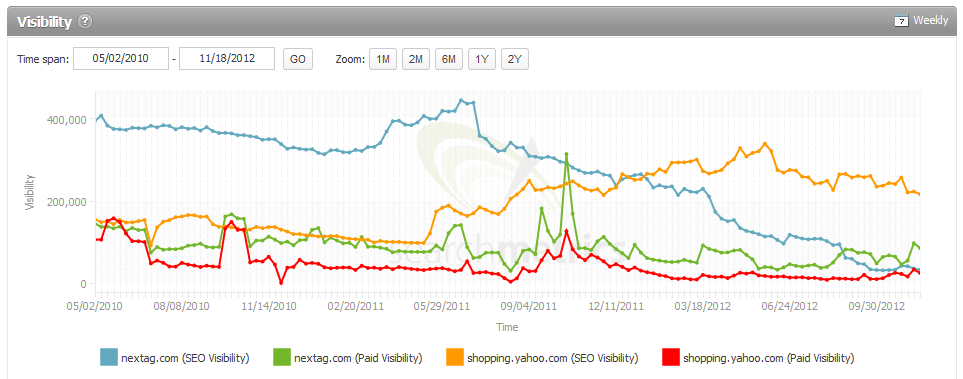
The above puts Nextag’s slide in perspective, but the problem is that they still have fixed costs to manage if they are going to maintain their editorial quality. Google can hand out badges for people willing to improve their product for free or give searchers a “Click any fact to locate it on the web. Click Wrong? to report a problem” but others who operated with such loose editorial standards would likely be labeled as a spammer of one stripe or another.
Scrape-N-Displace
Most businesses have to earn the right to have exposure. They have to compete in the ecosystem, built awareness & so on. But Google can come in from the top of the market with an inferior product, displace the competition, economically starve them & eventually create a competitive product over time through a combination of incremental editorial improvements and gutting the traffic & cash flow to competing sites.
“The difference between life and death is remarkably small. And it’s not until you face it directly that you realize your own mortality.” – Dustin Curtis
The above quote is every bit as much true for businesses as it is for people. Nothing more than a threat of a potential entry into a market can cut off the flow of investment & paralyze businesses in fear.
- If you have stuff behind a paywall or pre-roll ads you might have “poor user experience metrics” that get you hit by Panda.
- If you make your information semi-accessible to Googlebot you might get hit by Panda for having too much similar content.
- If you are not YouTube & you have a bunch of stolen content on your site you might get hit by a copyright penalty.
- If you leave your information fully accessible publicly you get to die by scrape-n-displace.
- If you are more clever about information presentation perhaps you get a hand penlty for cloaking.
None of those is a particularly desirable way to have your business die.
Editorial Integrity
In addition to having a non-comprehensive database, Google Shopping also suffers from the problem of line extension (who buys video games from Staples?).

The bigger issue is that issue of general editorial integrity.
Are products in stock? Sometimes no.
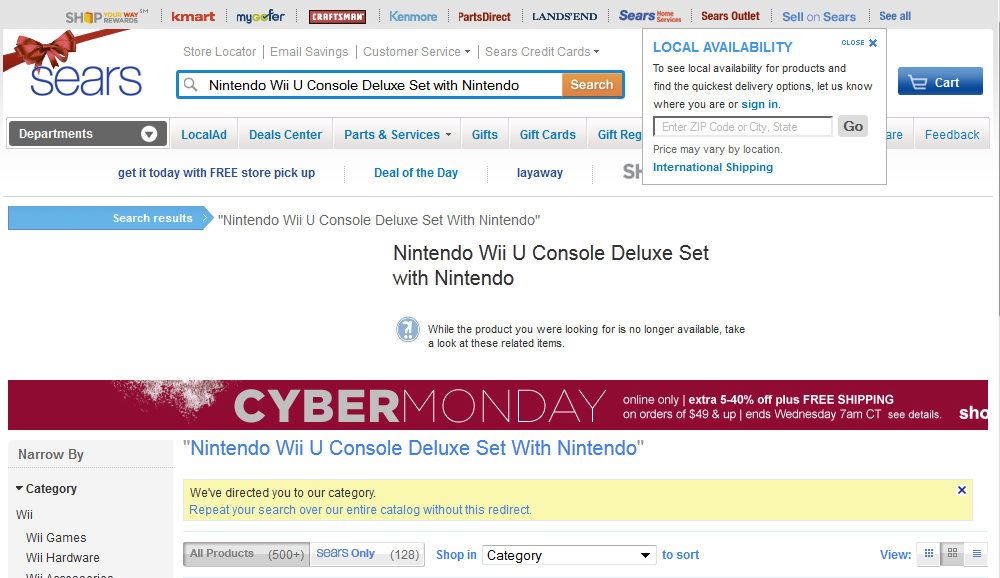
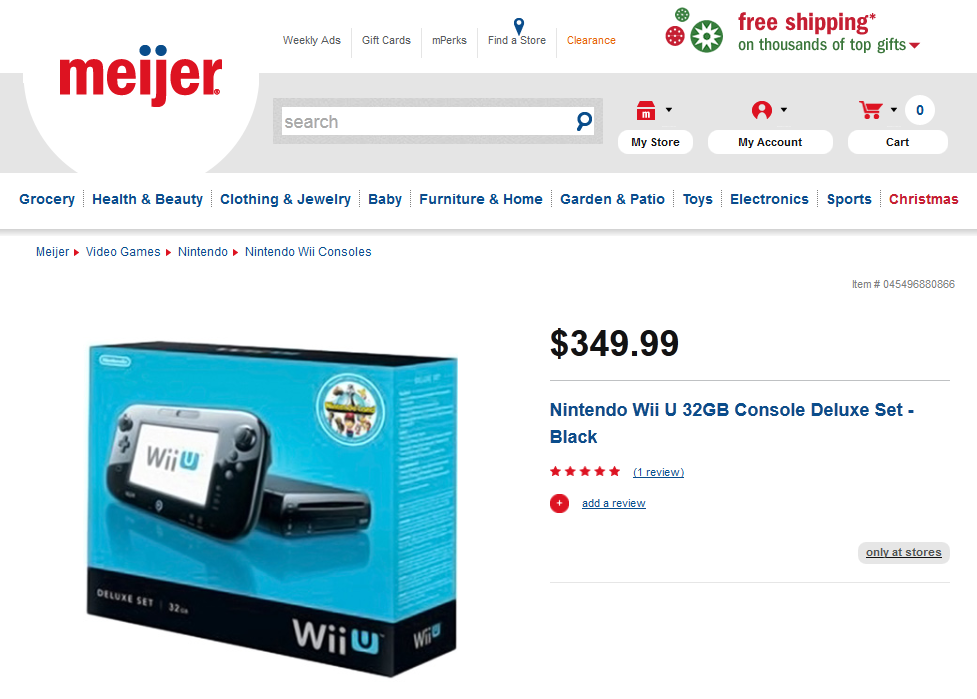
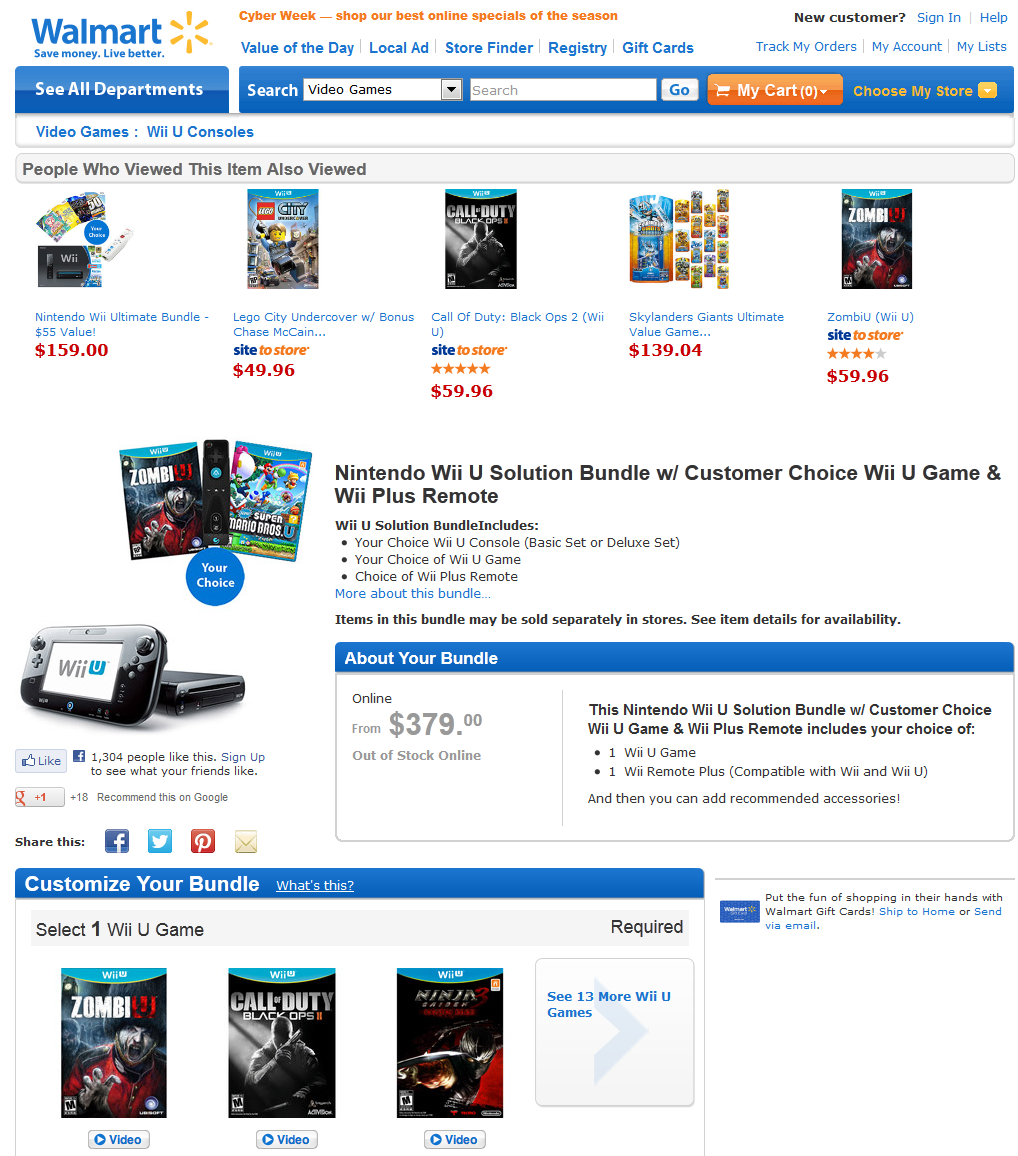
It is also worth mentioning that some sites with “no product available” like Target or Toys R Us might also carry further Google AdSense ads.
Then there are also issues with things like ads that optimize for CTR which end up promoting things like software piracy or the academic versions of software (while lowering the perceived value of the software).
Over the past couple years Google has whacked loads of small ecommerce sites & the general justification is that they don’t add enough that is unique, and that they don’t deserve to rank as their inventory is unneeded duplication of Amazon & eBay. Many of these small businesses carry inventory and will be driven into insolvency by the sharp shifts in traffic. And while a small store is unneeded duplication, Google still allows syndicated press releases to rank great (and once again SEOs get blamed for Google being Google – see the quote-as-headline here).
Let’s presume Google’s anti-small business bias is legitimate & look at Google Shopping to see how well they performed in terms of providing a value add editorial function.
A couple days ago I was looking for a product that is somewhat hard to find due to seasonal shopping. It is often available at double or triple retail on sites like eBay, but Google Shopping helped me locate a smaller site that had it available at retail price. Good deal for me & maybe I was wong about Google.
… then again …
The site they sent me to had the following characteristics:
- URL – not EMD & not a brand, broken English combination
- logo – looks like I designed it AND like I was in a rush when I did it
- about us page – no real information, no contact information (on an ecommerce site!!!), just some obscure stuff about “direct connection with China” & mention of business being 15 years old and having great success
- age – domain is barely a year old & privacy registered
- inbound links – none
- product price – lower than everywhere else
-
product level page content – no reviews, thin scraped editorial, editorial repeats itself to fill up more space, 3 adsense blocks in the content area of the page
- no reviews, thin scraped editorial, editorial repeats itself to fill up more space, 3 adsense blocks in the content area of the page
- no reviews, thin scraped editorial, editorial repeats itself to fill up more space, 3 adsense blocks in the content area of the page
- no reviews, thin scraped editorial, editorial repeats itself to fill up more space, 3 adsense blocks in the content area of the page
- the above repetition is to point out the absurdity of the formatting of the “content” of said page
- site search – yet again the adsense feed, searching for the product landing page that was in Google Shopping I get no results (so outside of paid inclusion & front/center placement, Google doesn’t even feel this site is worth wasting the resources to index)
-
checkout – requires account registration, includes captcha that never matches, hoping you will get frustrated & go back to earlier pages and click an ad

It actually took me a few minutes to figure it out, but the site was designed to look like a phishing site, with intent that perhaps you will click on an ad rather than trying to complete a purchase. The forced registration will eat your email & who knows what they will do with it, but you can never complete your purchase, making the site a complete waste of time.
Looking at the above spam site with some help of tools like NetComber it was apparent that this “merchant” also ran all sorts of scraper sites driven on scraping content from Yahoo! Answers & similar, with sites about Spanish + finance + health + shoes + hedge funds.
It is easy to make complaints about Nextag being a less than perfect user experience. But it is hard to argue that Google is any better. And when other companies have editorial costs that Google lacks (and the other companies would be labeled as spammers if they behaved like Google) over time many competing sites will die off due to the embedded cost structure advantages. Amazon has enoug scale that people are willing to bypass Google’s click circus & go directly to Amazon, but most other ecommerce players don’t. The rest are largely forced to pay Google’s rising rents until they can no longer afford to, then they just disappear.
Bonus Prize: Are You Up to The Google Shopping Test?
The first person who successfully solves this captcha wins a free month membership to our site.











